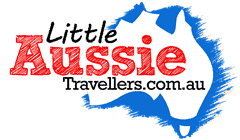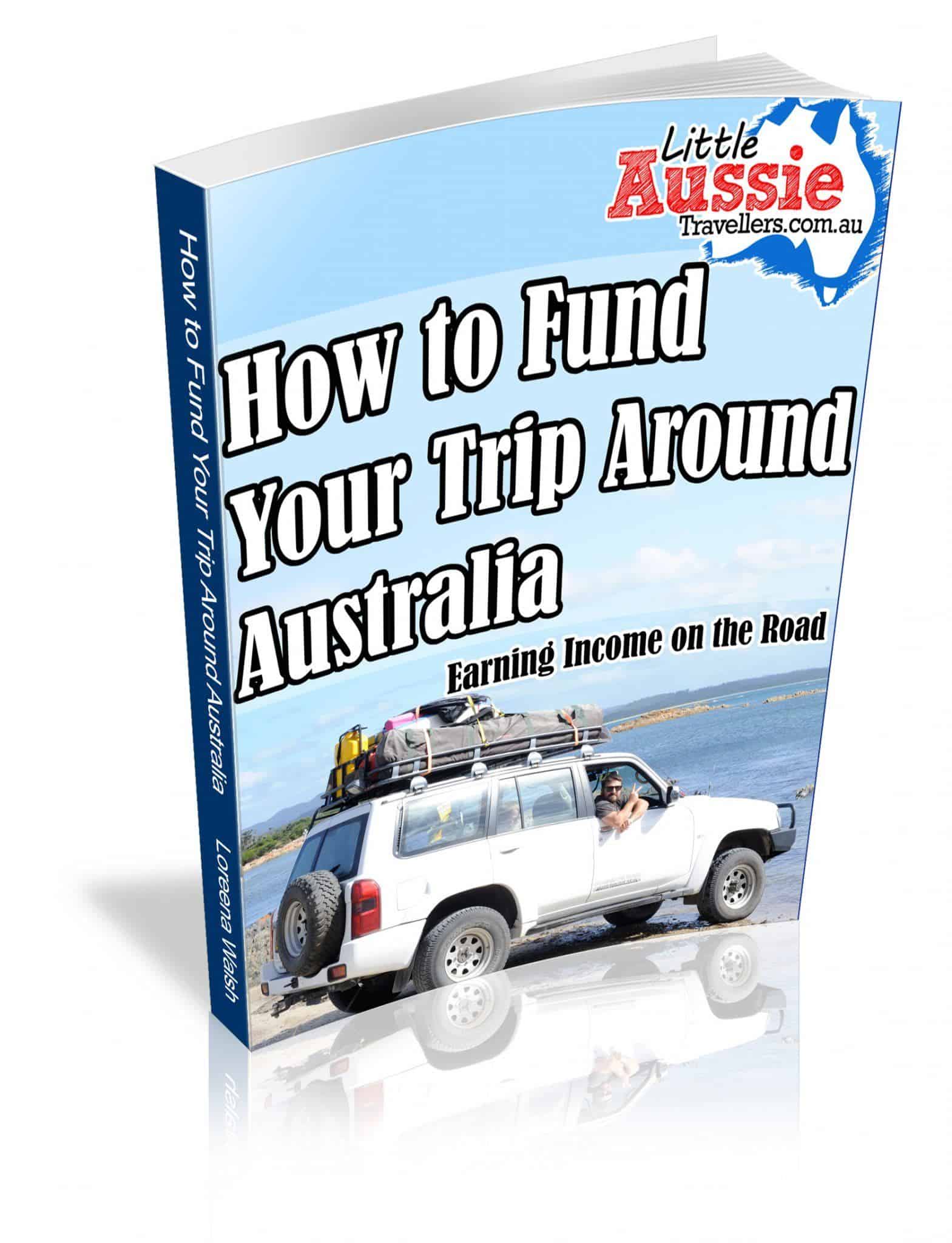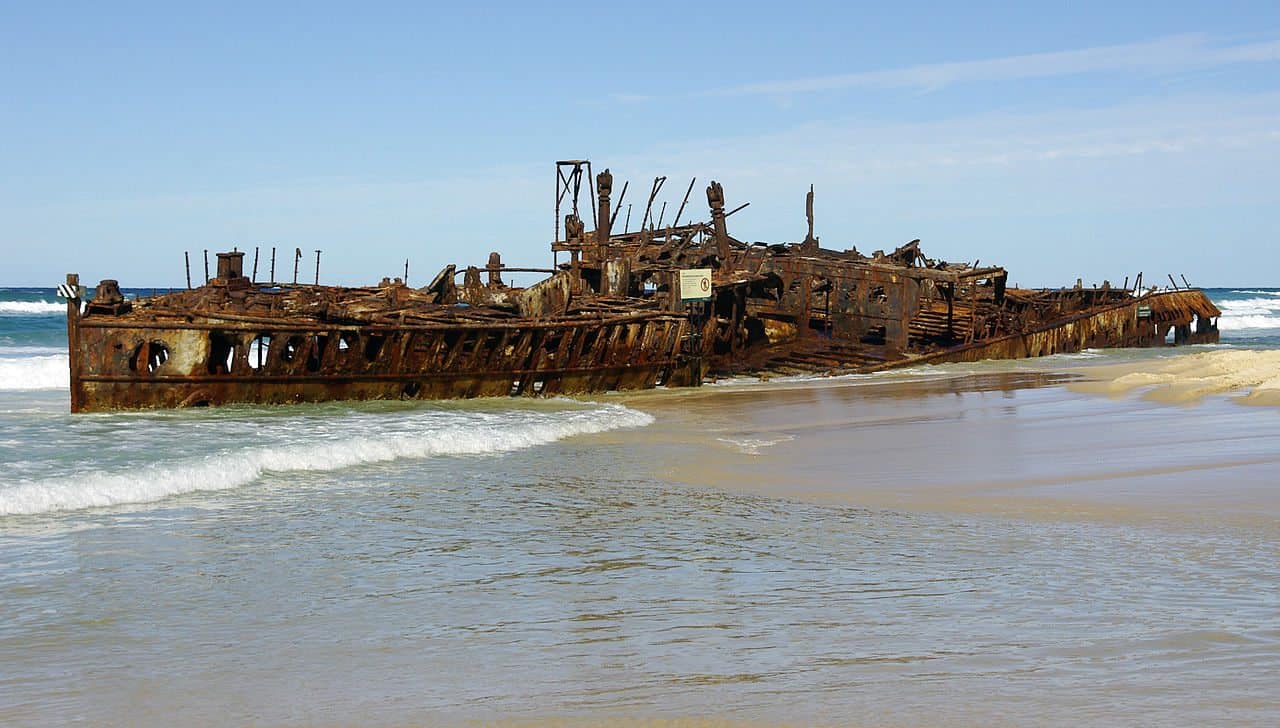
by Loreena Walsh | QLD Destinations & Activities
It is unbelievable to me that what was supposed to be a 2 week stop last June, has turned into an almost year long halt to our travels as we’ve spent time with Matt’s Nan. I wouldn’t change that time we’ve had to spend with her for the world, but I really have to admit we are keen to get back out exploring and travelling. I have itchy feet! So, we’ve been living vicariously through TV travel and 4wding shows, and recently watched a Pat Callinan episode on Fraser Island, and all I have to say is wow! Friends who have gone to Fraser on a tour with Sunset Safaris had a great time and had already tempted us with all their tales of adventure, but watching the landscapes unfold last weekend on T.V., well let’s just say that Fraser is now at the top of our list for first places to visit when we hit the road again.
We’ve been researching great things to do, and are sharing some of our ideas here with you. We’d love to know if you have any other hot tips.
Top Tips for Fraser Island
Fraser Island, located on the Queensland coast near Hervey Bay, is the world’s largest sand island and is World Heritage Listed. It’s a natural paradise spanning some 166,000 hectares with over 100 fresh water lakes and a beach highway stretching 120 kilometres. You can visit Fraser Island independently and explore as the master of your own adventure. For those taking their own vehicle, there are daily barge services from River Heads and Inskip Point. There is camping available but National Park permits will be required, as will 4wd permits for driving through many areas. For those wanting to explore with a local’s view, then you can look into a collection of Fraser Island tours like we mentioned above that our friends have done in the past. While you’re there, make sure you tick off as many of these things as you can, because it’s a truly unique Aussie destination.
Indian Head
Drive along almost the entire stretch of 75 Mile Beach to Indian Head, the coastal headland on the eastern side of Fraser Island. Marvel at the giant headland from below or get your walking shoes on and climb the track to the top for panoramic views and the perfect vantage point for spotting whales and dolphins around the point.
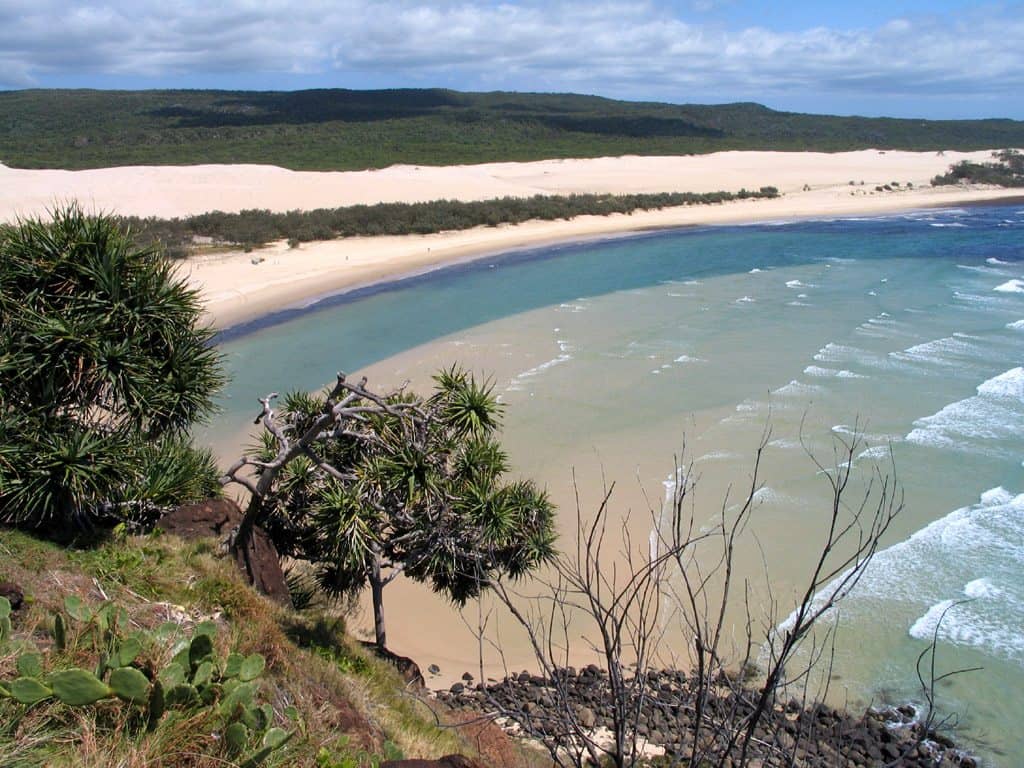
Lake Wabby
If you’re not afraid of a little exercise, visiting Lake Wabby will get your heart pumping. Lake Wabby is slowly being filled in by the sand dunes that surround it, so you should make it the top of your list.
Lake McKenzie
Lake McKenzie is pure paradise with soft white sand and crystal clear water. You can park close to the lake and walk down the track for a swim and then back up to the picnic area for a bite to eat.
Eli Creek
Eli Creek is refreshingly cold, even on a hot summer’s day. Follow the crowd and walk up the boardwalk before floating back down the creek with the current. It is quite shallow, so just relax and enjoy the tranquility.
The Champagne Rockpools
Located at the very top of 75 Mile Beach, you have to drive up and around Indian Head to access the Champagne Rockpools. Splash around in the salt water pools, but watch the sea as it crashes over the rock ledge.
Kingfisher Bay
Take the inland 4WD tracks from 75 Mile Beach to Kingfisher Bay and relax in the guest section of the luxurious resort. Walk along the jetty with an ice-cream in hand and dip your toes in the water after a long lunch.
The Maheno Shipwreck
What was once a washed up shipwreck is now a rusted landmark as you drive from one end of 75 Mile Beach to the next. Pull over, have a look around, and learn about the ship’s history and how it came to be stranded on Fraser Island shores.
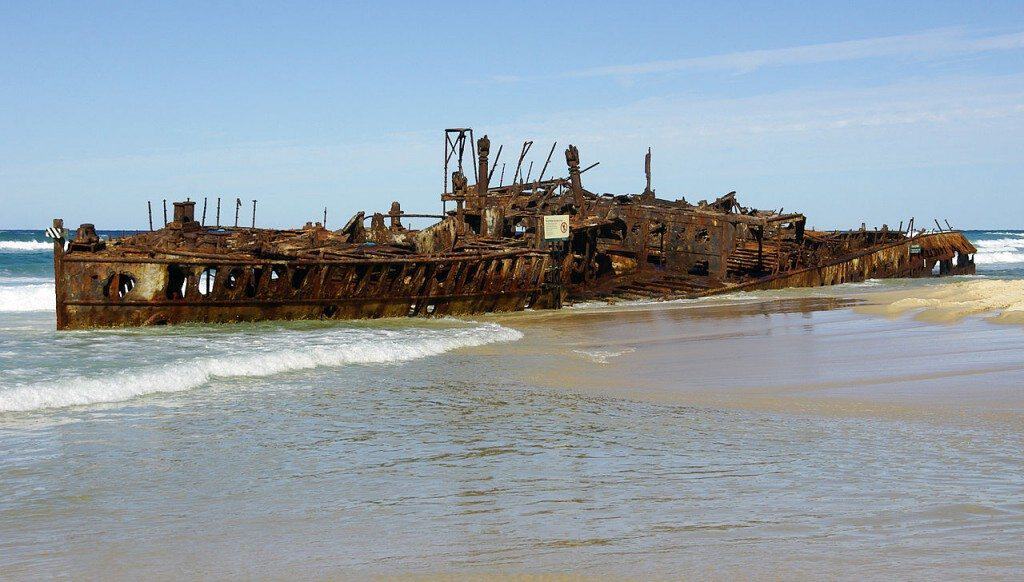
Lake Birrabeen
Much like Lake McKenzie, Lake Birrabeen is a crystal clear lake surrounded by soft white sand and a lush green rainforest inland from the main beach. Lake Birrabeen is popular among tourists for its calm and cool water.
The Coloured Sands
The many colours of sand you’ll spot on Fraser Island is breathtaking as you drive from Hook Point right up to Indian Head. There’s mustard yellow, sandy brown, burning orange and bold red, burgundy, brown, camel and white.
Central Station
On your journey across island on the inland tracks, you’re likely to come across Central Station. It is the perfect place to stop for a snack amongst the lush greenery and loud wildlife before continuing on to your next destination.
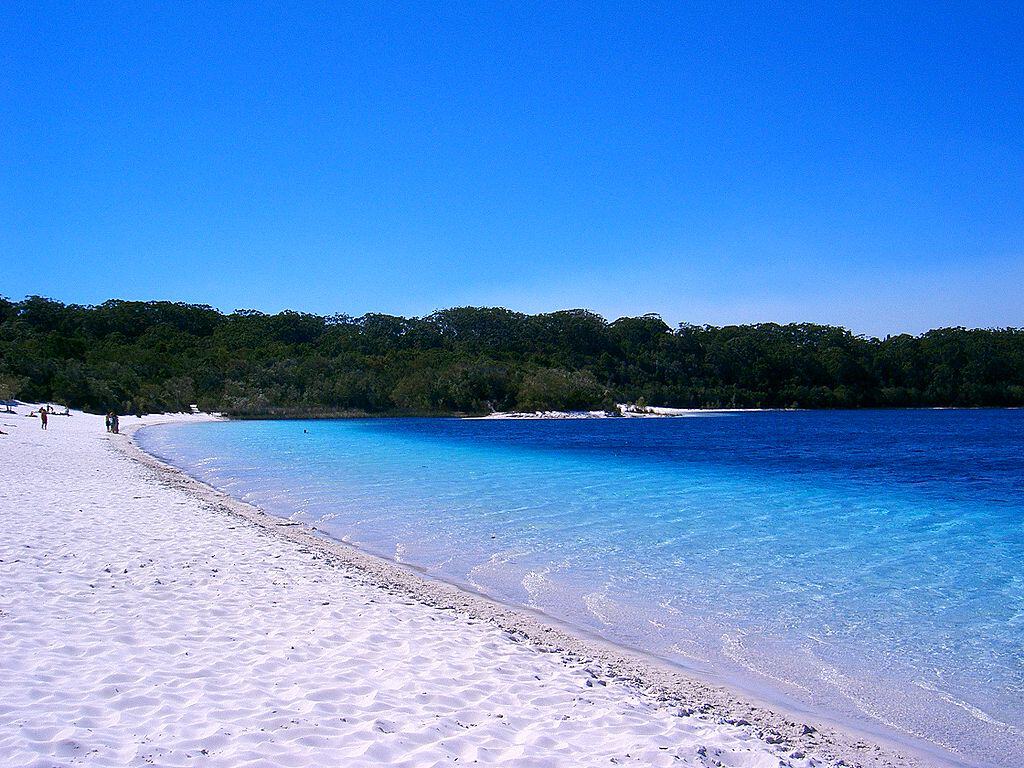
Are you now inspired more than ever by the amazing landscape and things to do on Fraser Island? Spend a week in a holiday home or camping on the beach as you explore hidden parts of the island as well as Fraser’s most loved locations. You can get lots of other information from the official Fraser Island tourism website, and I bet you’ll be as keen to get there as we are. We can’t wait to explore later this year and uncover what we find and share it with you!
If you’ve been to Fraser, please let us know how much you loved it!
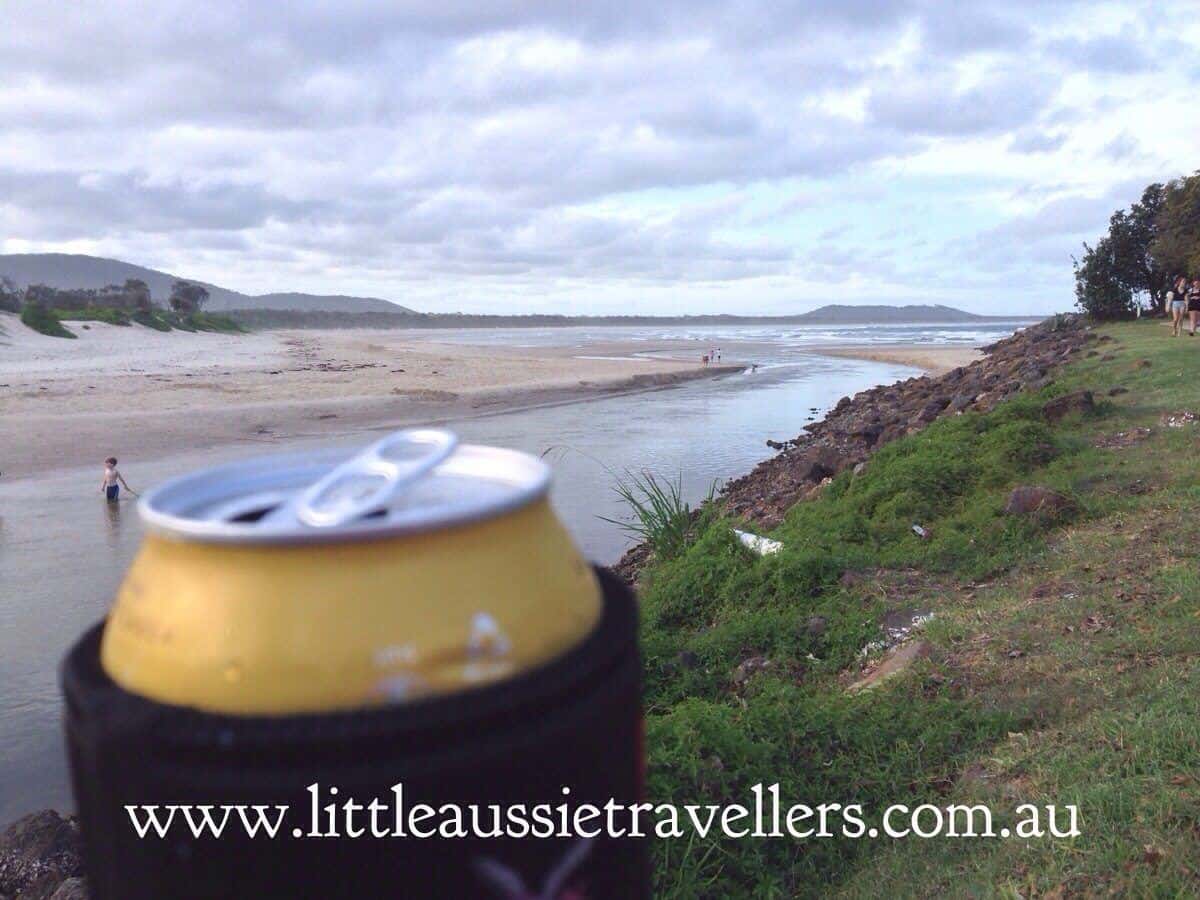
by Loreena Walsh | Featured Posts, NSW Destinations & Activities
Sometimes, you need to leave a place to realise just how special it is; and it’s not that I didn’t always love Crescent Head, but when you live in an area like the Mid North Coast of NSW, you tend to take it for granted.
So, while we’ve been home doing the caravan renovation, Crescent Head has become a little haven for us. Somewhere we can escape for some family time, get some relief from the heat, and take in the awesome coastal views and kick back enjoying the outlook while the kids enjoy the creek.
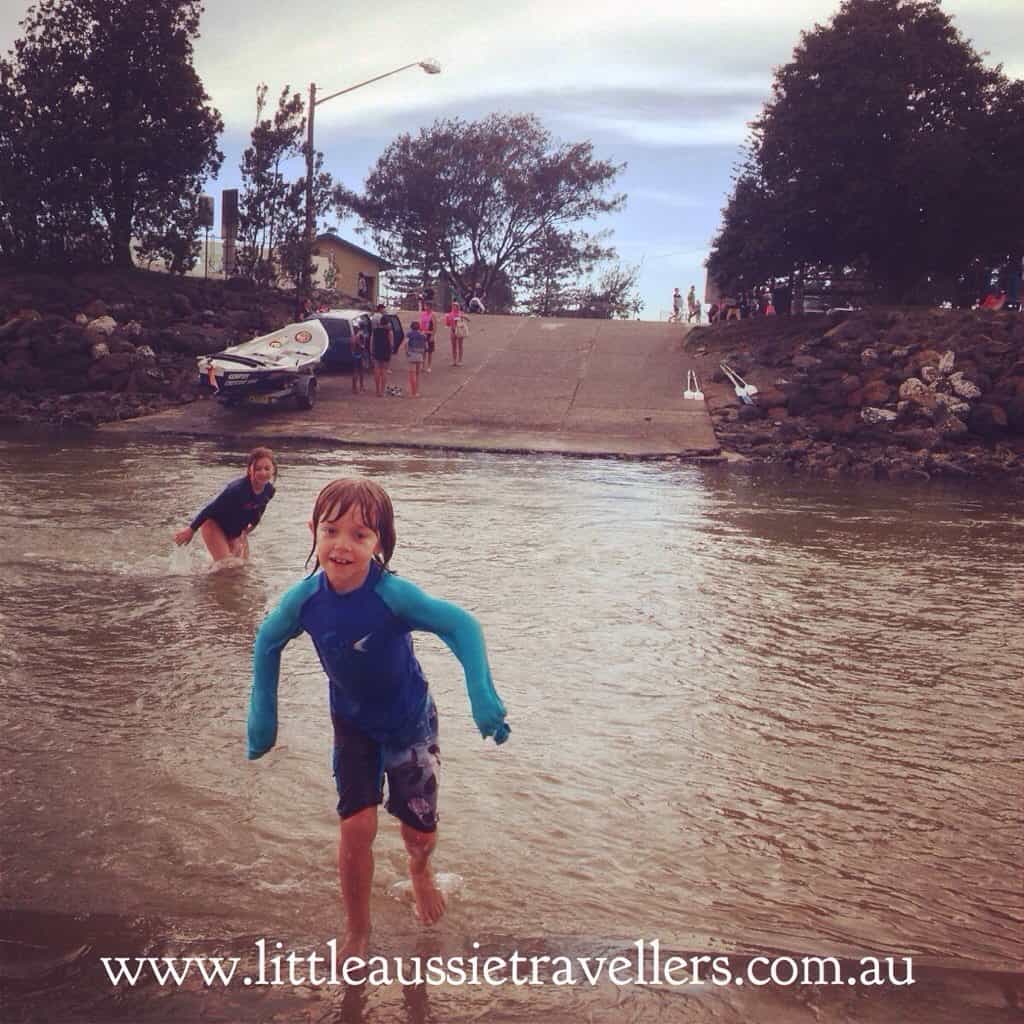
Things to do in Crescent Head.
If you’d like to enjoy a beer or wine with a great view, there’s the tavern or the golf club, there’s great rock pools. If you’re looking for a camp ground, then there’s the super convenient caravan park right on the beach, or you’ve got Racecourse camp ground, Delicate Nobby or Point Plomer camp grounds that are all great too, with differing facilities.
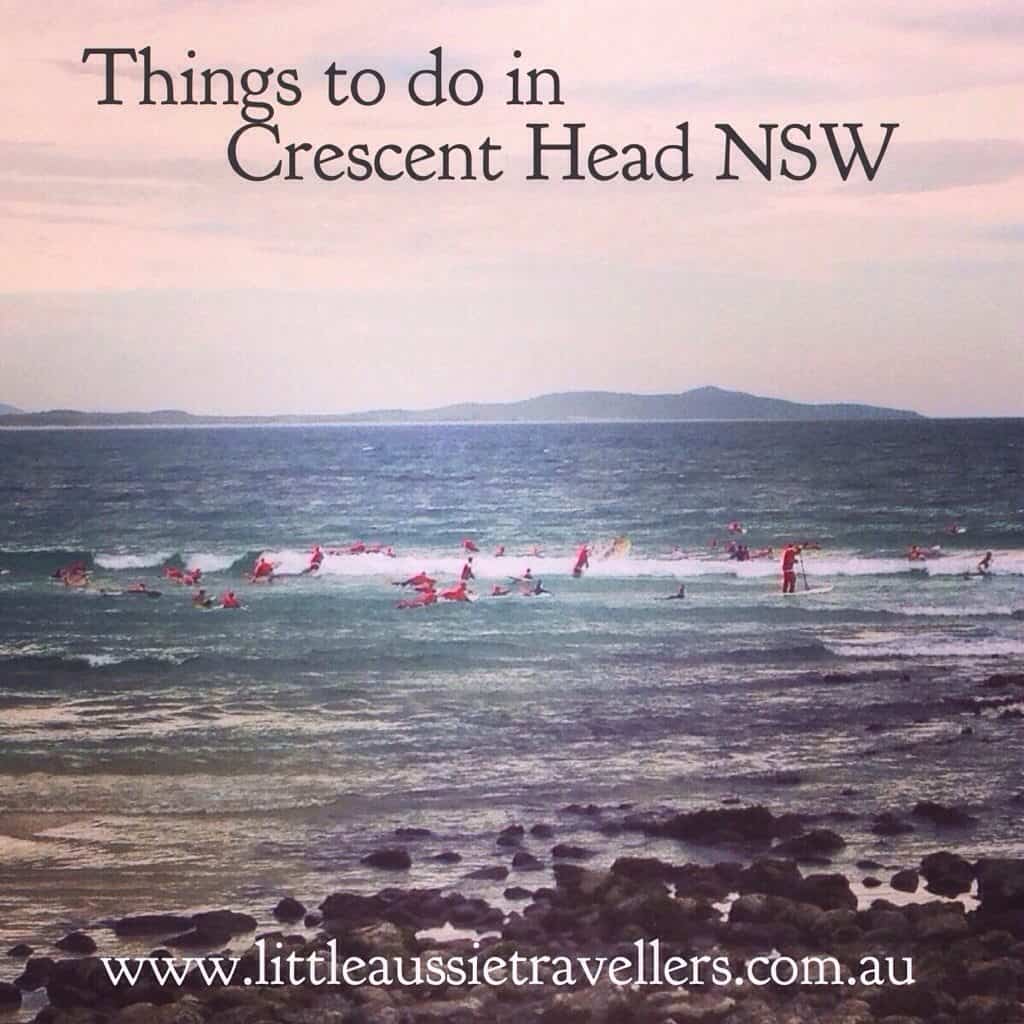
It’s worth heading to Big Hill to do the rainforest walking track. Spend a couple of hours and enjoy the beautiful views from the headland. To get there head along Point Plomer road until you get to Big Hill, which should be about 15 kms, and the walk leaves near the picnic area.
We had lots of fun watching the Santa Surf on Christmas Eve, and if you’re ever in the area over the Christmas period then it’s definitely a must-see! Great atmosphere and lots of fun. I think we might even let the kids participate if we’re back again for Christmas.
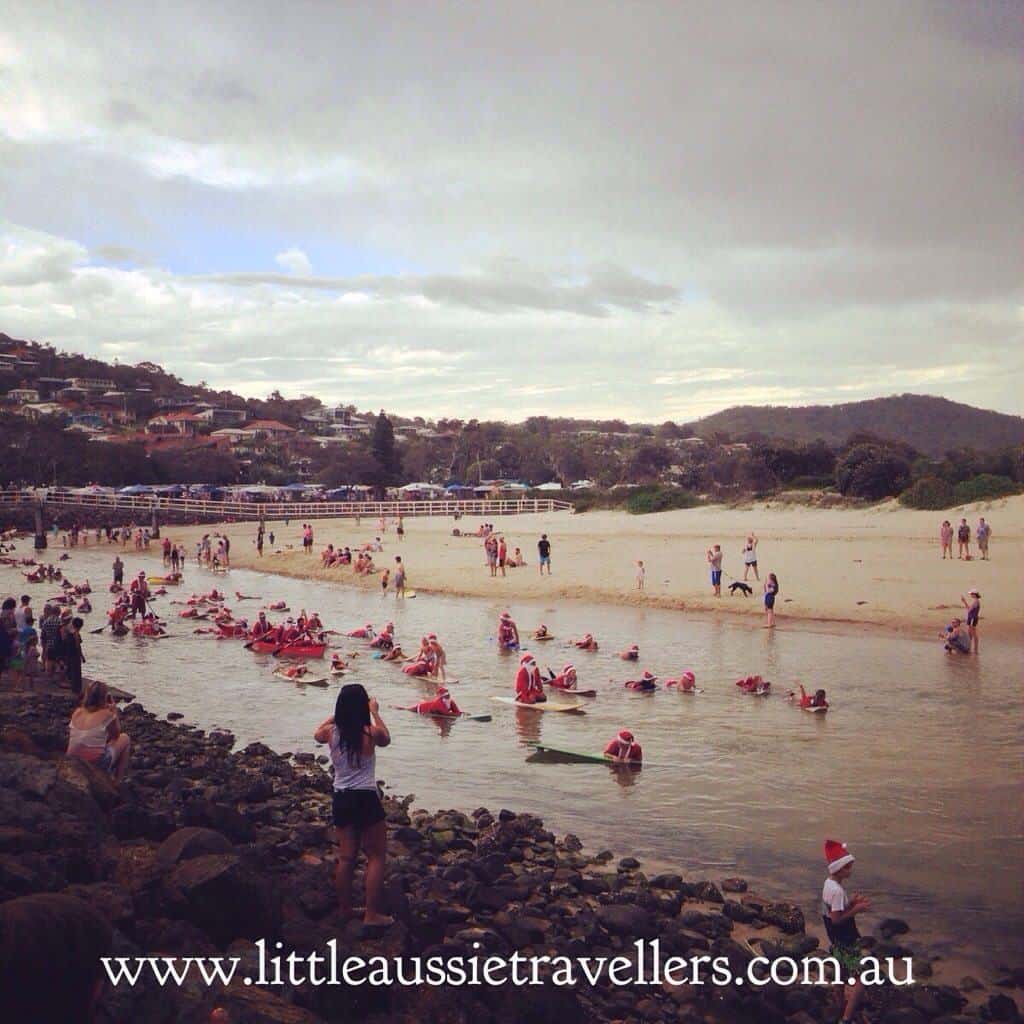
You can spend your time fishing, surfing, swimming and just relaxing. There’s always a great friendly atmosphere in town, and don’t forget to follow the road up through the houses to the water tower where you can look out.
Facilities Near Crescent Head.
You’ll find everything you need in town, there’s a small supermarket and all supplies you will need for camping or a day trip. Kempsey is close by with major supermarkets and Big W and Port Macquarie is about a half hour drive south with major shopping complexes, movie theatres and more beaches.
Really, if you’re after some time out, in a beautiful, peaceful part of the coast, where there are secluded natural wonders just waiting to engulf you in peaceful, sun-filled bliss, then a visit to Crescent Head should definitely be high on your list of priorities. I really think we’ll miss it when we leave the area again soon.
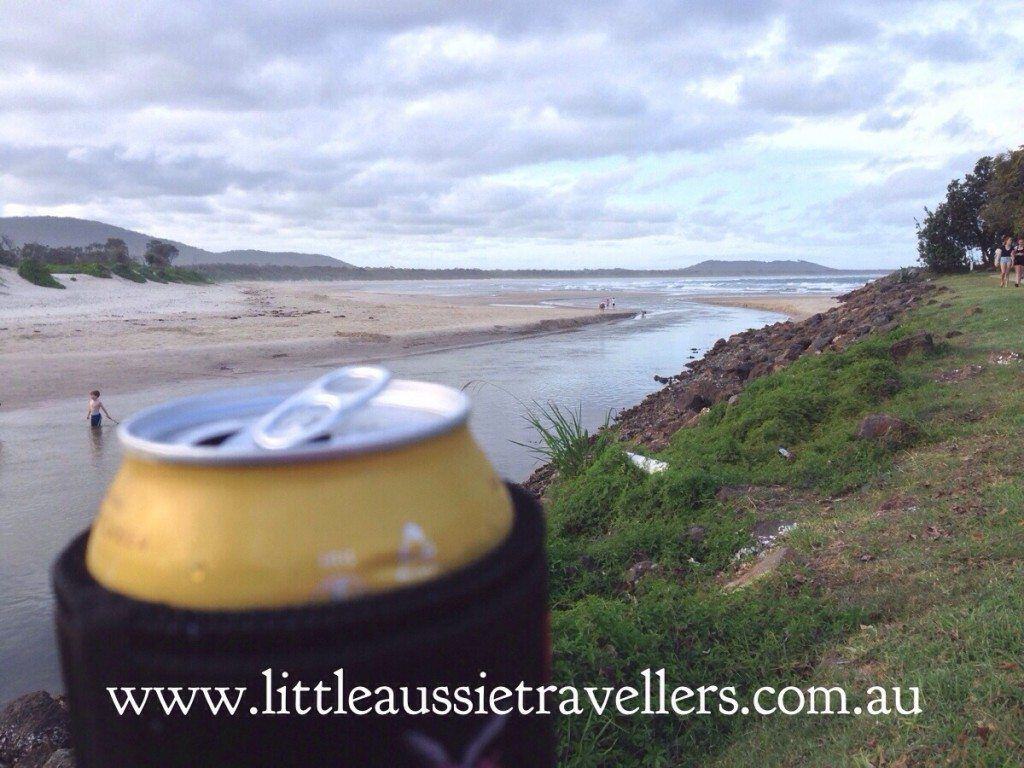

by Loreena Walsh | Featured Posts, Indigenous Culture, TAS Destinations & Activities
I’ve written many times about how we fell in love with Tasmania, but perhaps one thing I haven’t spoken enough about, is the Indigenous history of Australia’s island state.
There’s a reason for that; during our 3 months in Tasmania, although we learned a lot of history, I’m sad to say we didn’t learn much about Tasmania’s first peoples. There were snippets on a couple of signs, and a small amount I managed to track down at Port Arthur, but sadly I don’t feel there’s enough information in general tourist areas. There may be more accessible information on Flinders Island, Bruny Island or Maria Island but we didn’t make it to any of those, so perhaps that’s why we didn’t see more?
As someone majoring in Indigenous Studies, and because I wasn’t satisfied with what I learned, I’ll tell you what I know myself, and I hope, if you visit, you’ll track down something wonderful and send me information. I do intend to re-visit Tassie and track down more for myself.
I set off on our adventure keen to uncover how settlement may have affected Indigenous peoples in Tasmania, who before settlement knew the island as lutruwita (lu-tru-wee-tah). In 1803 settlers arrived to form Australia’s second British colony at Risdon Cove, and it was named Van Diemen’s Land as part of the New South Wales settlement. In 1856 the island was granted self-government and the name officially changed to Tasmania. Of course, I realised that just like every part of Australia, settlement was likely a destructive time for Indigenous populations, but how destructive? What happened? Did any clans survive on their own lands? What was the initial reaction from either side?
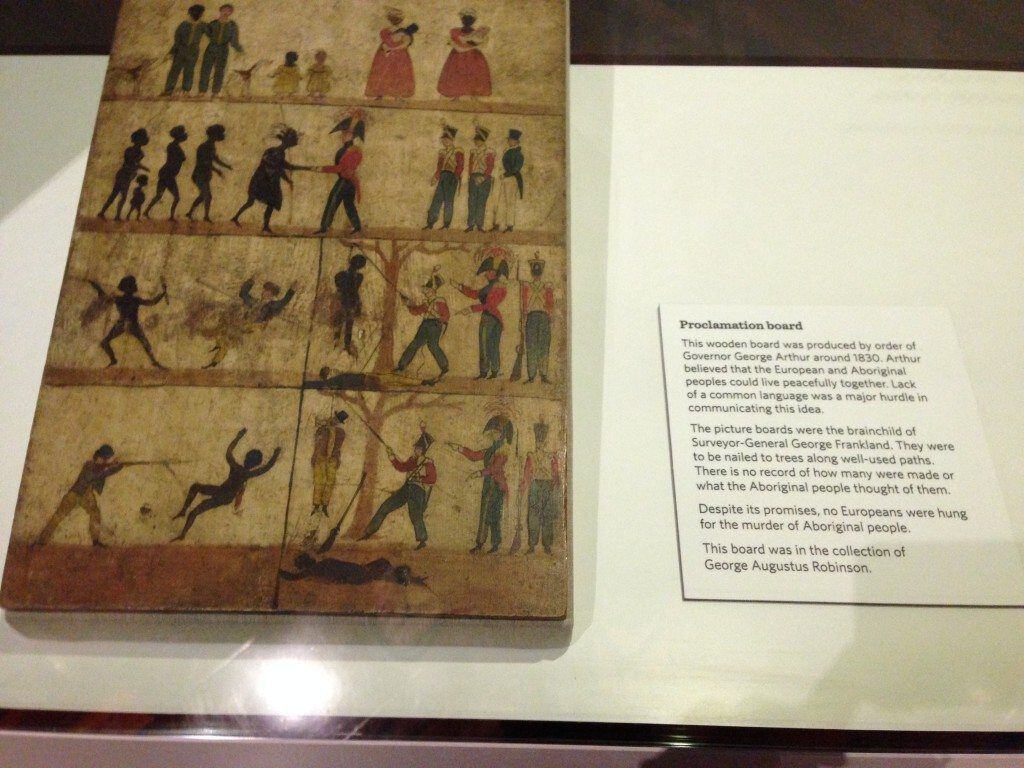
Unfortunately, the story isn’t a kind one.
Before settlement it is believed there were nine Indigenous Nations living on Tasmania, who traded with European sealers with very little animosity, but once settlement began, Indigenous peoples were pushed off their lands in order for settlers and convicts establish colonies and farmland. Land would be fenced off and distributed for farming and cropping, but when Indigenous peoples rely on their homelands for food and water, to fence this off means desperation and lack of ability to survive.
If you’d been living peacefully on lands for no less than 35,000 years and all of a sudden found your lands fenced off resulting in your family starving, what would you do? Of course you would need to fight, you would be driven to fight; fight for the right to eat, and stay alive.
Most people don’t understand that for the most part, Indigenous Australians were not historically a nomadic peoples, instead they existed in designated lands which they cared for and used to sustain all they needed, sometimes trading with neighbouring Nations for tools or foods they may not have access to on their own Country. So it was not as simple as being kicked off one area of land by settlers and moving on to somewhere else, Indigenous peoples could not just take over someone elses lands. Sadly this is the theme right across Australia, not just Tasmania, but on an Island state so small, losing lands would have had horrific consequences.
Lieutenant-Governor Arthur declared martial law in 1828 resulting in Aboriginal clans being forced out of areas and away from white settlers, murdered or incarcerated. Those who were not forced out were decimated by European diseases which killed many Indigenous peoples who had no immunity to such health issues.
Surviving Indigenous Tasmanian peoples were forced onto Bruny Island, Flinders Island, and other areas, where most died due to poor conditions and disease, before a settlement at Oyster Cove was formed and those who survived were mostly left to their own devices there.
There is, today a Tasmanian Indigenous population who have worked hard to revive and continue Indigenous language and connection to land and culture, so as proven right across Australia, our First Peoples are resilient and determined and this should be celebrated.
My Most Treasured Indigenous Insight While In Tasmania.
One area we did visit that holds Indigenous significance is Recherche Bay.

Many people would have heard of Truganini (1812-1876), a brave and amazing Aboriginal woman who survived the destruction and decimation of her peoples, caused by white settlement.
Truganini was born in Recherche Bay, daughter of the leader of the region. While much of Truganini’s family were brutally killed, Truganini travelled with her partner Woorraddy who accompanied George Robinson, serving as a guide and interpreter, during attempts to relocate Indigenous populations to several island settlements. During this time, Truganini became disollusioned with Robinson’s mission, realising that his attempt to remove and relocate Aboriginal peoples would all but remove the chance for traditional Indigenous life in Tasmania, and instead urged her peoples to stay and with them settled at Oyster Cove.
Truganini passed away in 1876, and is believed to have been the last surviving full-blood Tasmanian Aboriginal person. While fighting occured when her remains were recovered from the Hobart Female Factory site in 1878 after much protest and fighting, in 1976 her ashes were scattered on the D’Entrecasteaux Channel, fulfilling her wishes almost one hundred years after her death.
I, stood, one small person looking out the the D’Entrecasteaux Channel, and Recherche Bay, and with my standing, felt the gravity of settlement, the pain of a peoples who did not ask for us to be here, and the pain of one woman who fought for survival for herself and her peoples.
In all this sadness I felt a renewed hope that as a country we can move forward. We can never undo what has been done during the devastation caused by settlement, but we can be mindful and reflection and acknowledge that while we have grown into an amazing country, this has not been without loss and pain.
Together, as a united country we must not lose sight of the most important part of this country. The land. It has nurtured a culture now considered the oldest continuing living culture in the world, and we must care for the land so it continues to nurture the people who now call it home.
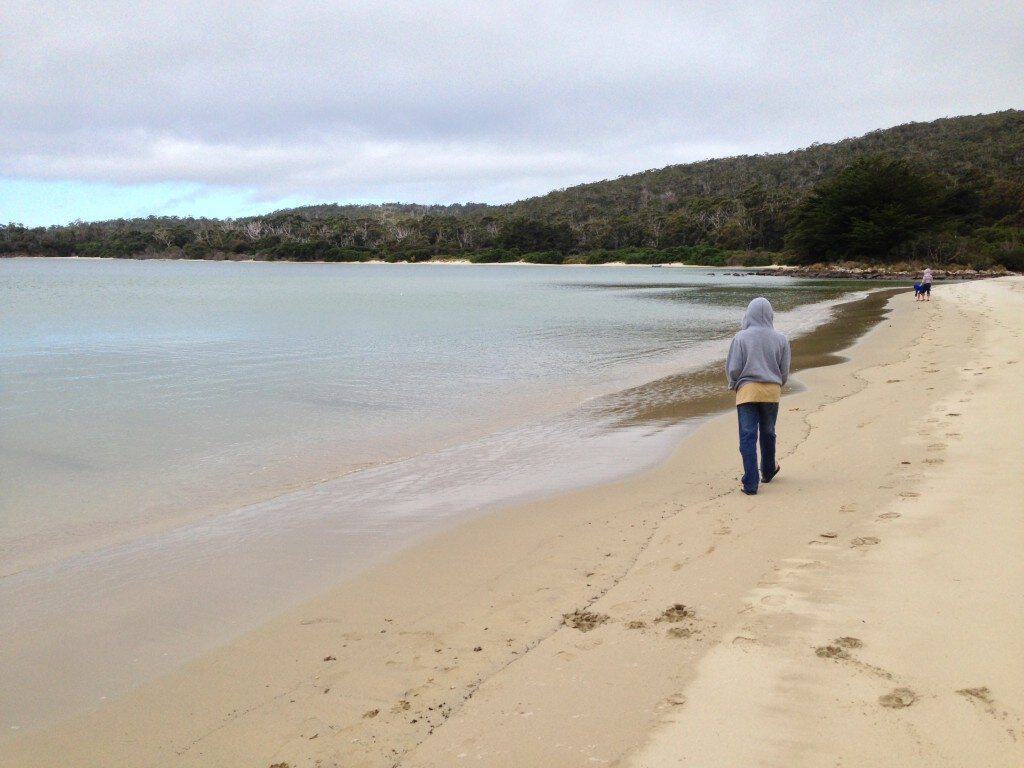
Do you have an interest in Indigenous History or special memories of Tasmania? Share below.

by Loreena Walsh | Indigenous Culture, NSW Destinations & Activities
You’ll rarely hear me call Kempsey home. I wasn’t born there, but I did live there through my teenage years, and I met Matt there (during our highschool years), but for little fault of it’s own, Kempsey has never really felt like a positive place for me.
It was where I got my first job, my first boyfriend and completed highschool, and where I always felt I’d “escaped” from, as soon as highschool was over.
I’ve begrudgingly returned back on many occasions, swearing it was a place I’d never live again, stopping in only to visit family.
You know what’s sad about that?
Kempsey and the Macleay Valley Region is an amazingly beautiful place.
We’ve been back in the region longer than we’d planned, and we’ve been making the most of it. We’ve been heading to Crescent Head regularly and I love that little town; it holds memories of my teens and it’s a stunning place to let the ocean soothe your soul. We’ve been swimming in the river; the same one I spent many summers cooling down, even though the water levels are really low at the moment, the kids had a great time, and we’ve experienced some wonderful community events.
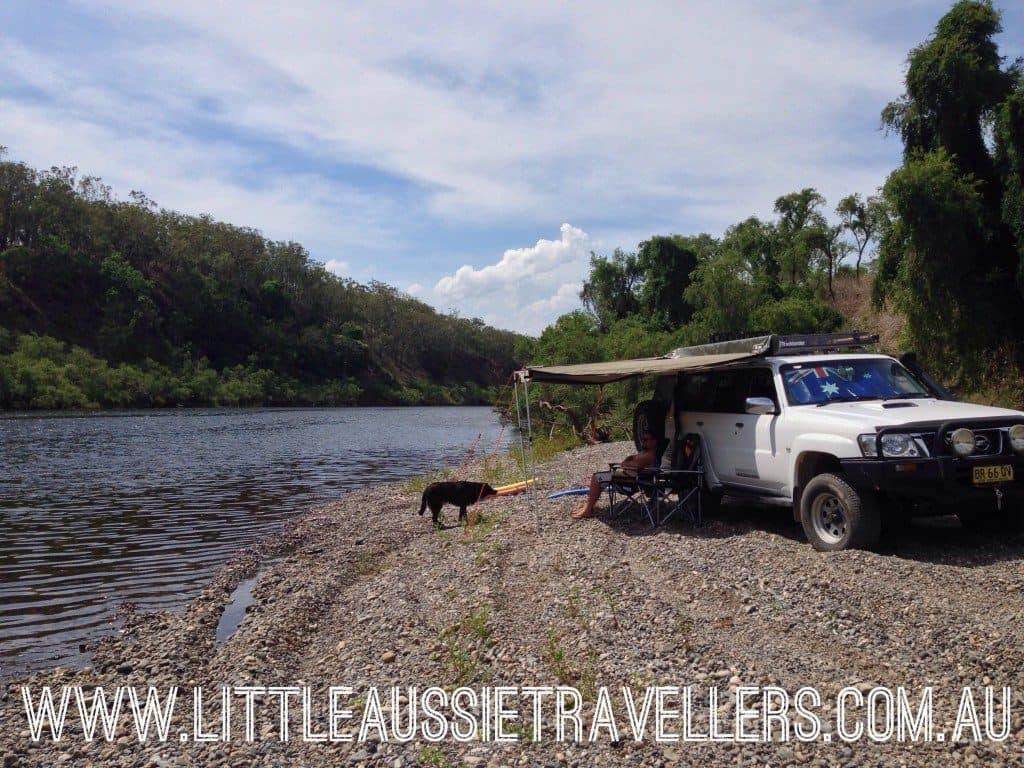
But, while I’ve always felt quite a negative attitude to Kempsey, I’m glad I’ve had the chance to have my mind changed, and I’m happy to eat my words!
The Macleay River Festival.
We’ve taken the time while we’ve been here to get out and about and enjoy some events within the community, and what can I say, but I am so glad to see such positive events taking place in Kempsey. I’ve written before about the joy I feel in learning about Indigenous history in this region and others, and after doing some reading I found this festival was a celebration of the river, of Indigenous peoples appreciation of the river, and also the joy and importance the river has in contemporary society today.
Kempsey was settled on the land of the Dunghutti, “of which there are four tribes Dangaddi, Dainggati, Thungutti and Djunghatti” (Macleay River Festival, 2014)
The river is a central part of Kempsey; it sustains life, it brings devastating flooding, it is mother nature at her most beautiful. It was wonderful to see, that in the spirit of the river, the community of Kempsey connected, together, celebrating, as one peoples.
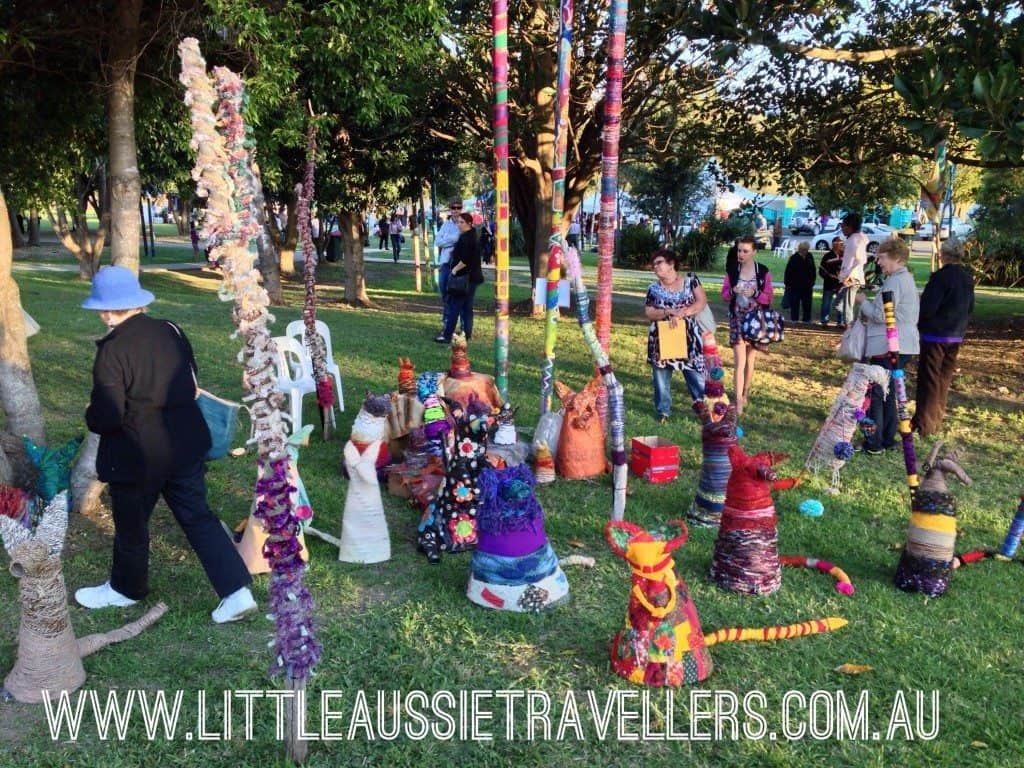
The festival was inspired as a celebration of the river, the area and the Indigenous peoples that have called Kempsey home for thousands of years. From the festival website:
“festival aims to showcase the spirit and diversity of culture and experiences in the Macleay.”
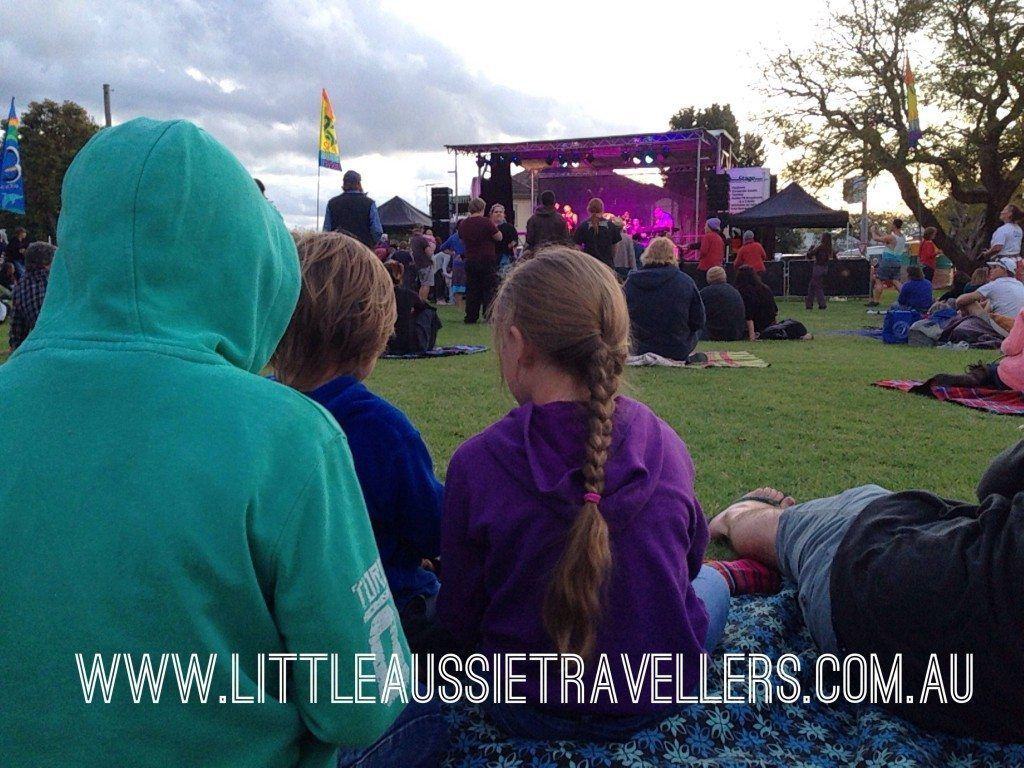
Well, what can I say, but the festival was an amazing success. With an amazing mix of culture, art, markets, music, comedy, local performers and a relaxed laid back atmosphere that families could enjoy, we all had a wonderful time.
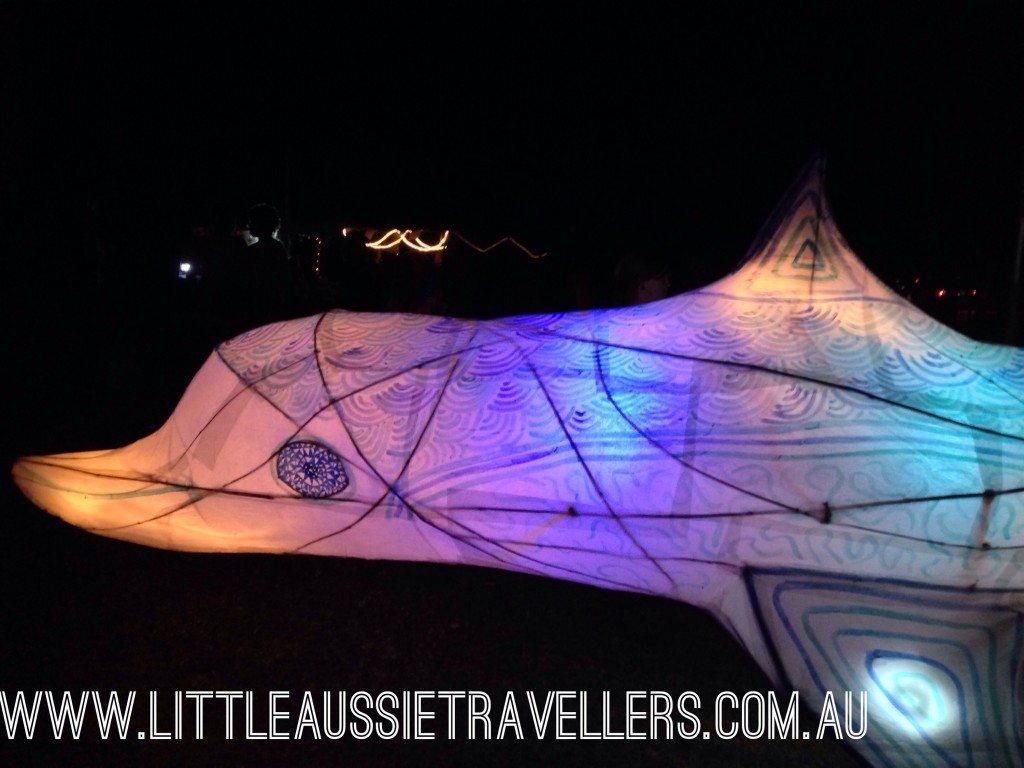
While Kempsey may be an area that has had it’s problems, and suffers many of the same issues that other low socio-economic towns experience, seeing the community togetherness and celebration was heartwarming and a positive sign that the community can strengthen and create a wonderful culture of togetherness and joy in the natural beauty the region offers all people who live here.
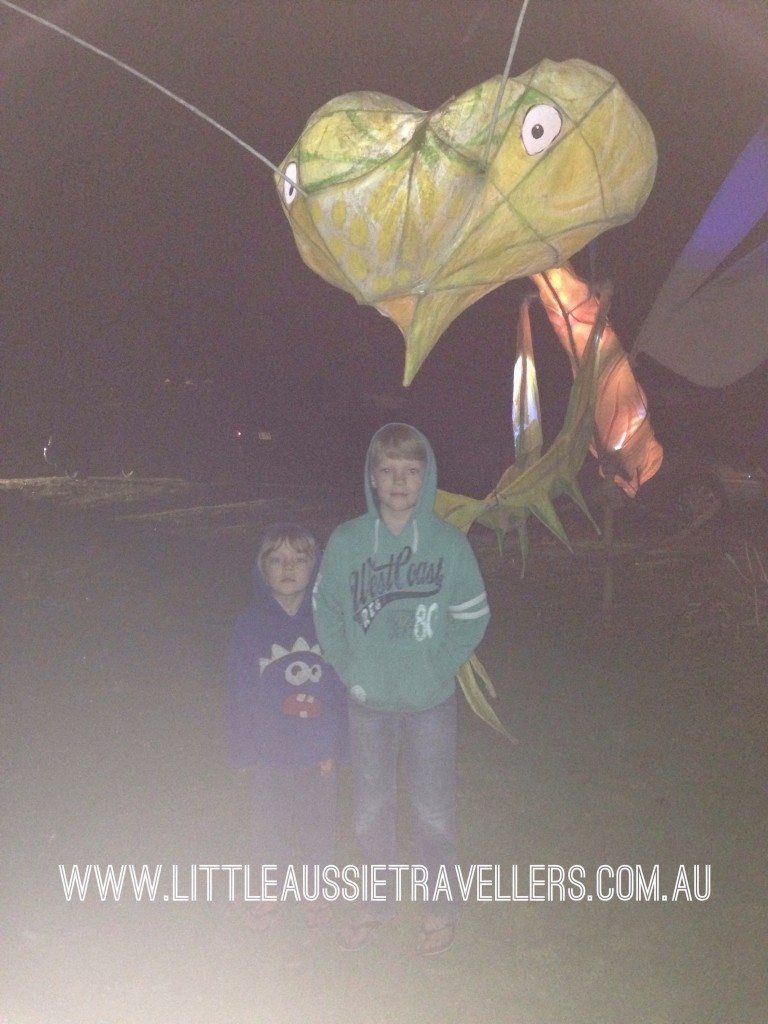
Kempsey Twilight Market
We returned back to Riverside park in Kempsey to watch the fireworks that were some of the best we’ve ever seen for the Kempsey Twilight Market. The markets are always a wonderful mix of food, craft, clothing and art as well as nick-nacks and entertainment. I did a little clothes shopping, and even in the rain, crowds gathered to watch entertainment from local school students, and the fireworks seriously went for what seemed like forever and the kids were over the moon.
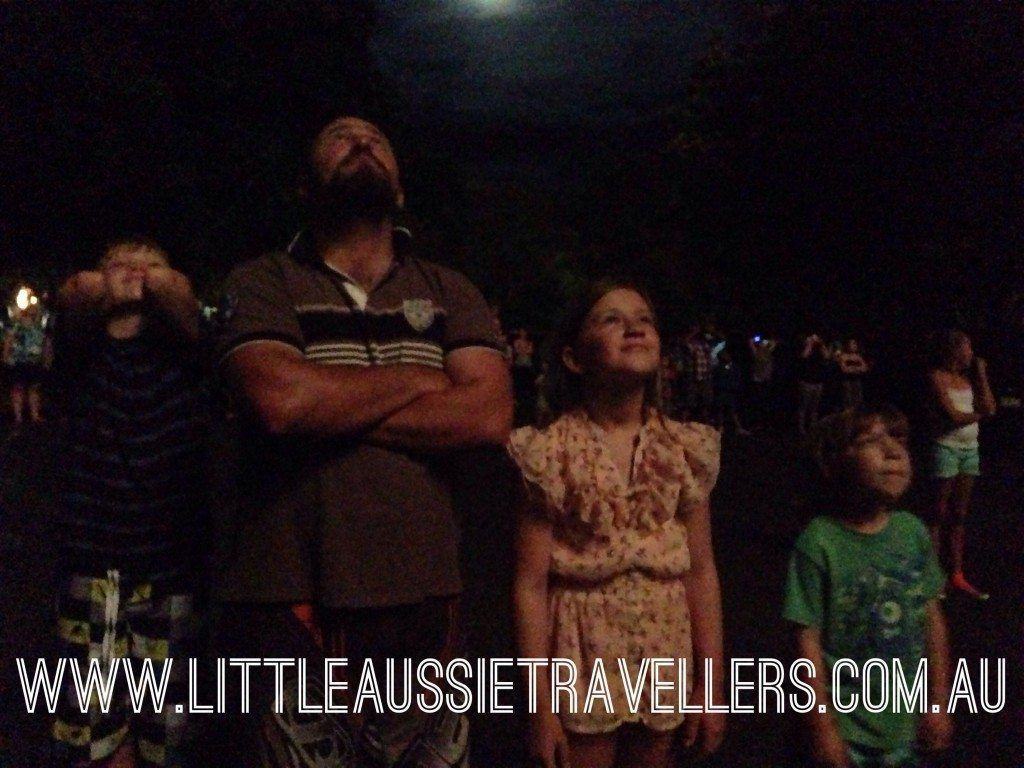
So I have to admit, I’ve admitted, I’ve been a bit rough on Kempsey all these years…..
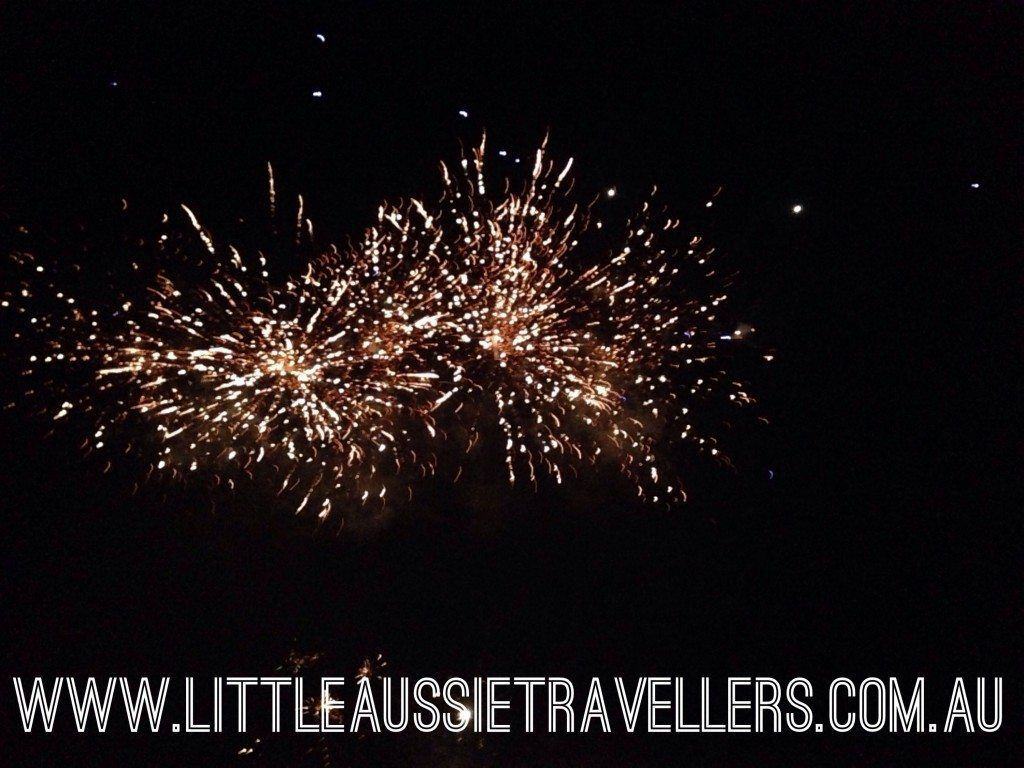
When you’ve spent years being stubborn and being negative about a region, sometimes it pays to give it another chance. There is lots about Kempsey that’s great, and I’m glad we’ve had the opportunity to see it all with fresh insight.
So, if you’re visiting the Mid North Coast of NSW, then be sure to stop in and visit.
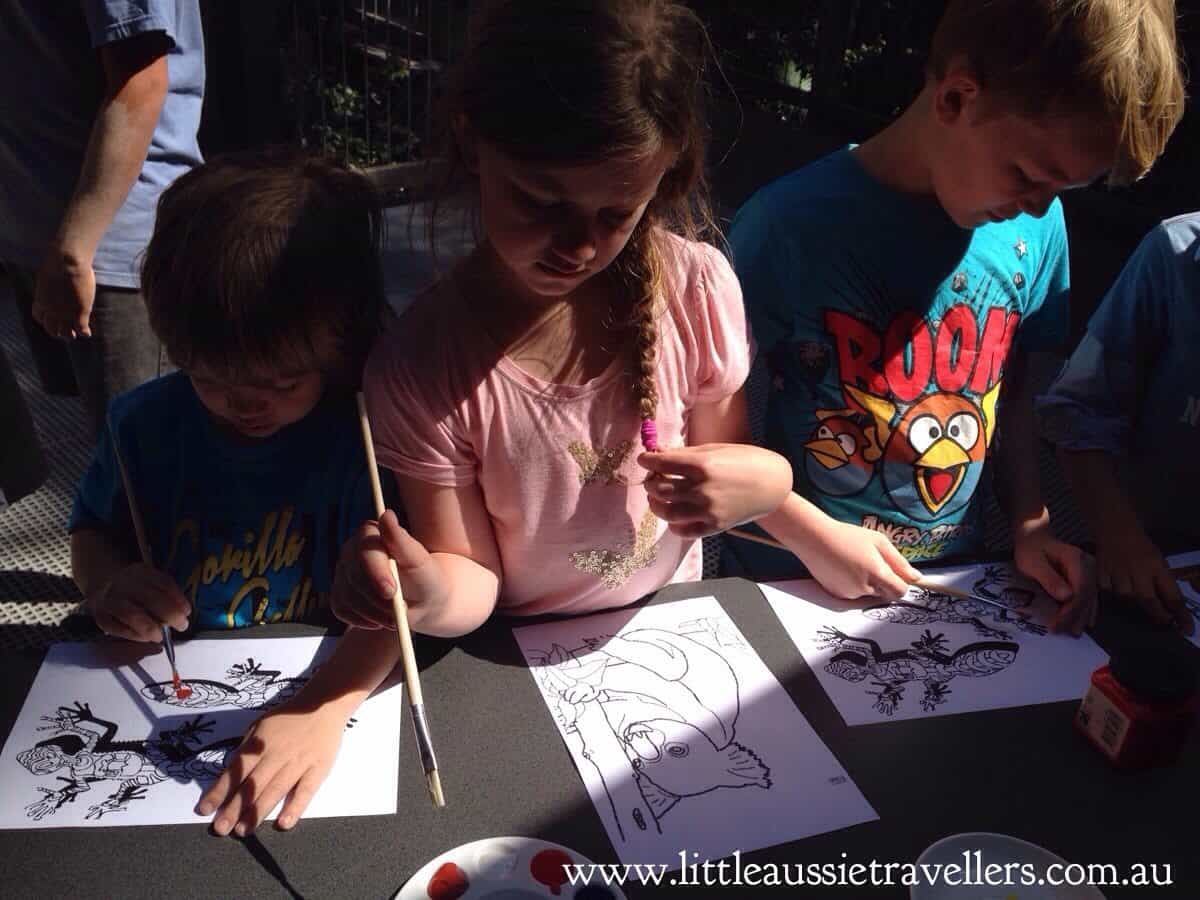
by Loreena Walsh | Indigenous Culture, NSW Destinations & Activities
The best kinds of days are those you think are going to be good, and instead they end up being great. Today was one of those days. We were treated to an afternoon of Aboriginal culture, music, art, craft and great conversation with some wonderful, amazing hosts. We took part in Sea Acres Rainforest Centre’s “Aboriginal Art in the Rainforest” activity.
I’m beginning this blog post with a big hello to Aunty Rose, who took details of our blog with her today so she could take a look. Hi Aunty, and I hope you enjoy looking around the site. Then, another huge thank you for being so welcoming today to local artists Aunty Debb Robinson, Aunty Leah Bale, and Russell Moran you all ensured we had a wonderful afternoon full of both education and lots of fun!
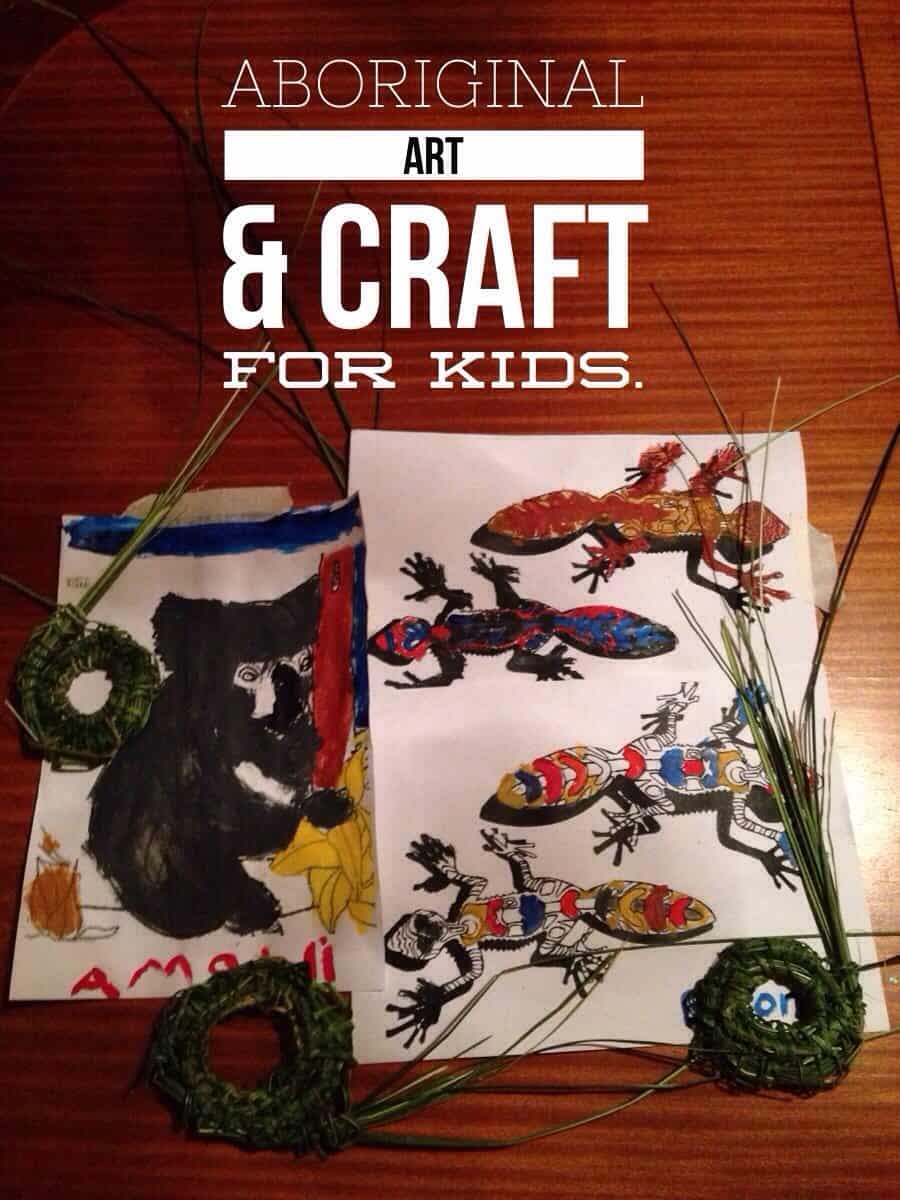
As some of you will know, I returned to University a couple of years ago to do my degree in Indigenous Studies. This decision was driven by my respect and passion for the amazing Aboriginal culture, hunger for knowledge and understanding, and the ability to ensure that I can be a positive part of ensuring that Australia does not lose this amazing history, and above all that my children grow up with respect and knowledge.
My belief is, that no matter what your cultural background, it is important for every Australian to embrace Aboriginal culture and celebrate the stories, beauty and spirit of the lands on which we all live here in Australia. So, when I get the chance to celebrate, share and learn about our home region with my kids, I always love to do the activities at Sea Acres Rainforest Centre.

We received a welcome to country from Russell, and did some singing along with Aunty Debb, who is a great singer. Then we were treated to the Kamilaroi people’s story of the “Emu in the Sky” which gave me goosebumps. The Emu in the Sky story shares knowledge of the changes to the milky way, and the connection of the appearance of an Emu amongst the Milky Way and the breeding cycle of the Emu on the land. These changes would signal to the Kamilaroi when they could collect emu eggs, and when they must stop. We also learned how the Koala lost his tail.
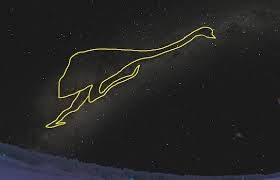
No matter how many dreaming stories I hear, I am forever in awe of the connection of the plants, the waters, the stars and planets and the animals on the land. Everything is so connected, and I wish people in general understood and appreciated this more.
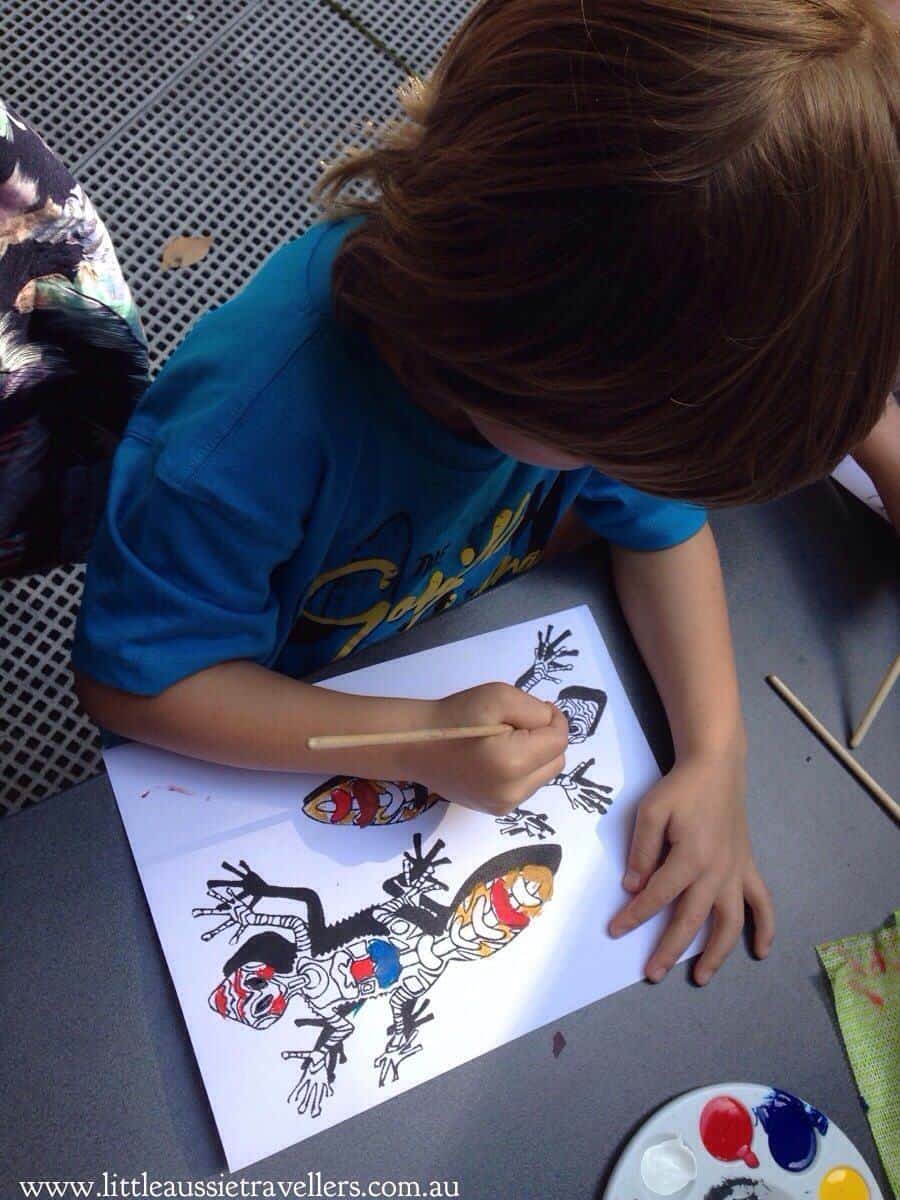
The kids really enjoyed doing painting activities of native animals, the boys in their usual style chose to paint geckos. They still miss our pet reptiles and are forever on the hunt for snakes and lizards while they are out exploring so it was an easy pick.
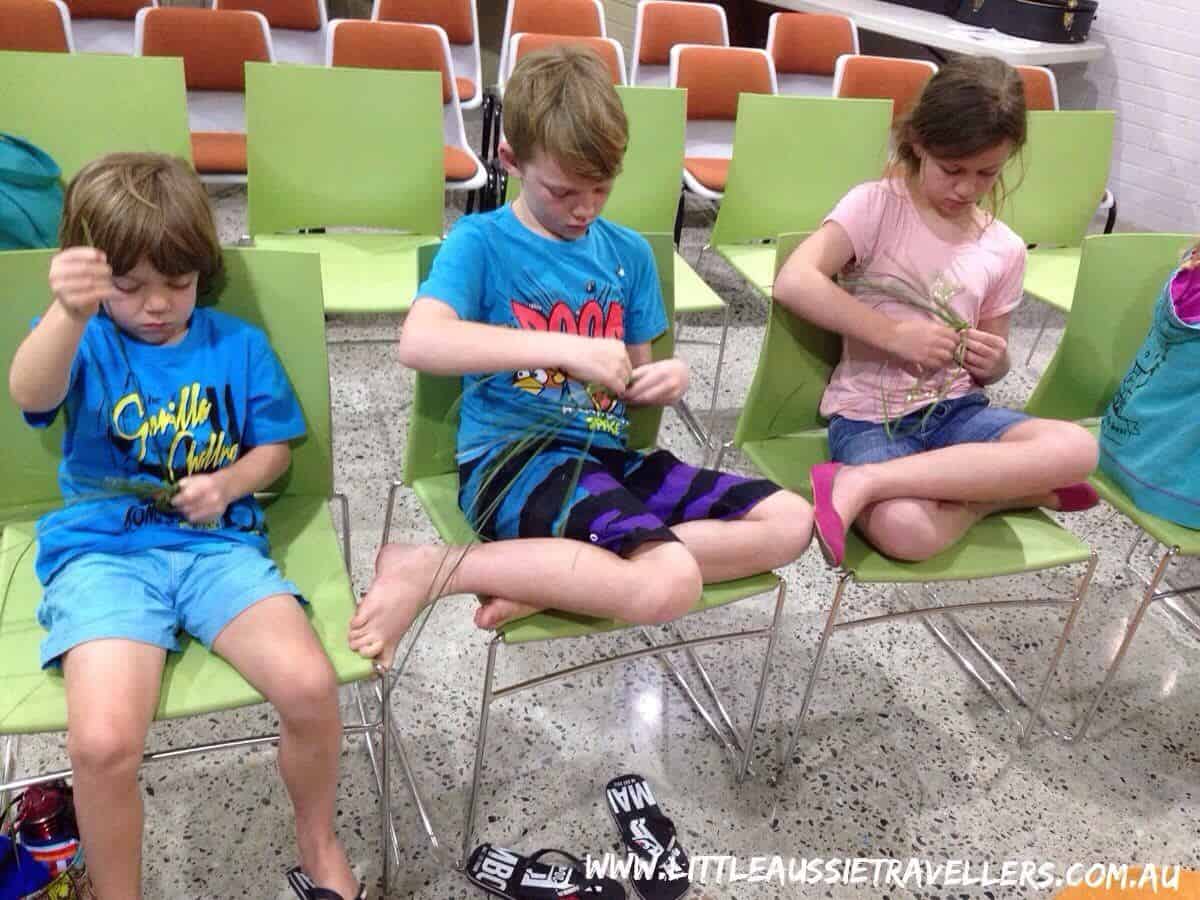
My personal favourite part of the day was the weaving workshop. Our first visit to the Northern Territory was the first time I saw weaving, and from that moment I was in love with the earthy beauty of bowls, bags, floor mats, wall hangings and all of their variations, woven by hand.
I have longed to learn the art of weaving, and I was overjoyed to get the chance to learn, alongside the kids and it was so much fun. Aunty Leah was telling us of a weaving project that stands as tall as herself, which took her three months to complete. Our first efforts aren’t particularly neat, but we’re definitely going to try harvesting our own Lomandra and getting in some more practice. It is a lovely, calming activity and my soul was as happy as I thought it would be, finally gaining an understanding of the process.
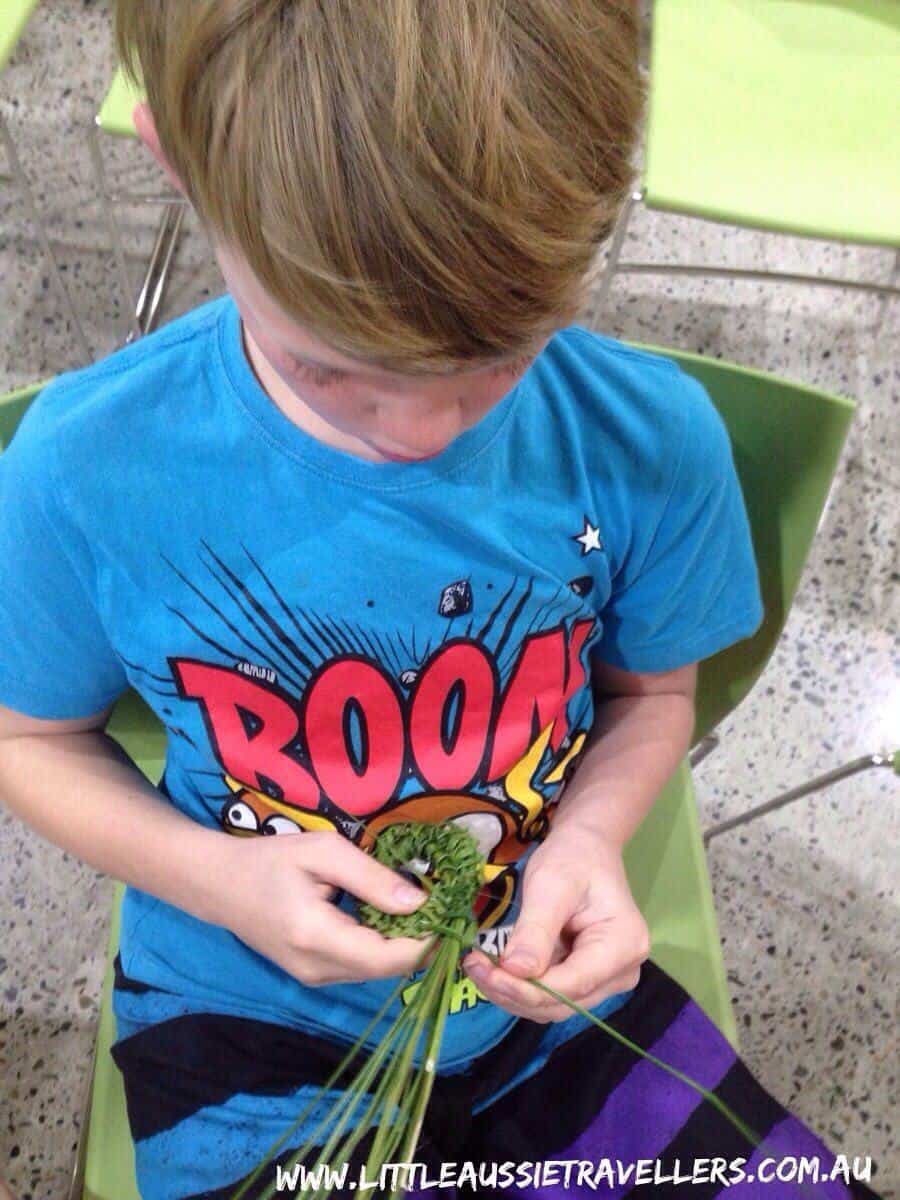
So, if you’re ever in Port Macquarie or surrounds during the school holiday period, then I can highly recommend taking part in any of the cultural activities on offer. We’ve been before and we’ll return again if we’re in the area.
A huge, huge, huge thank you again to Aunty Debb, Aunty Leah, Aunty Rose and Russell. I had a great day chatting to you all, and the kids had a wonderful day learning and doing the activities.
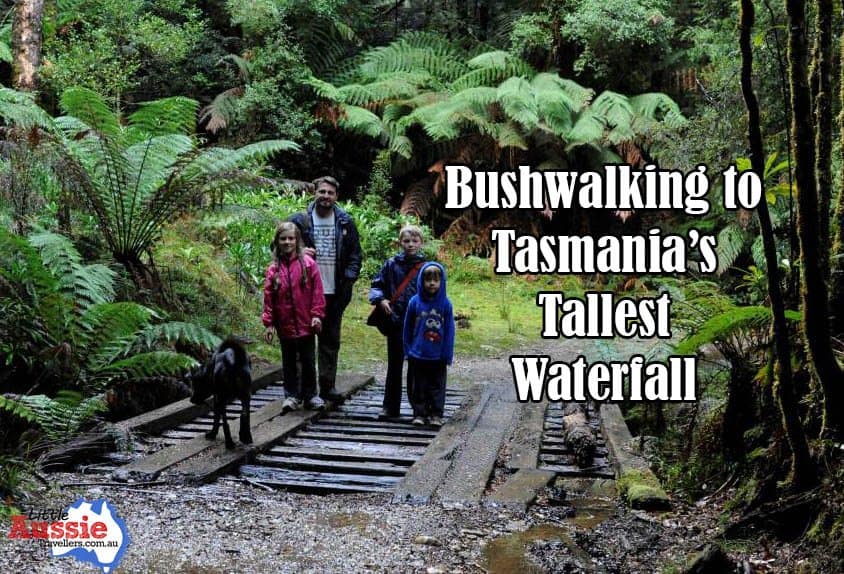
by Loreena Walsh | TAS Destinations & Activities
One of the wonderful things about being on the road, is never quite knowing where you’ll be on your birthday. For me, we ended up being in the West of Tasmania, meaning there was lots of amazing nature just waiting on our doorstep waiting to be discovered. The goal then became to walk to one of Tasmania’s tallest waterfalls: Montezuma Falls. There’s so many options for family bushwalking in Tasmania, but Montezuma was extra special.
We’d been camping at Henty Sand Dunes, not too far from Strahan, and had lovely weather for most of the time, but as the rain set in for a few days it made it more and more difficult for the kids to enjoy the dunes, so moving to a new site seemed like the perfect thing to do when the rain broke the day before my birthday.
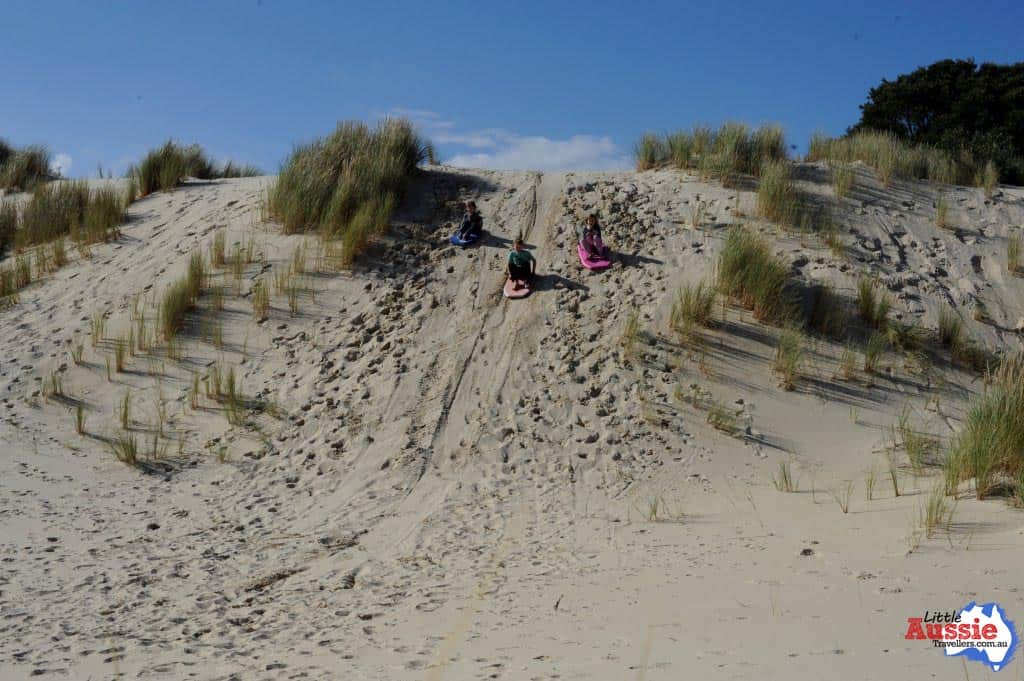
We spent the night in an overnight free camp near Rosebery called Stitt Park, which provided a safe, clean place to park the van on a rainy night so we would be close to Montezuma Falls for the morning. You’ll find it on Wikicamps which is what we use to find our free camps.
After a rainy morning, the skies pulled back their grey clouds to reveal the stunning blue we’d known for most of our time in Tassie, and so we set off for the walk hoping the drizzle would hold off for the afternoon, and it didn’t disappoint.
The road to Montezuma is slightly windy, nothing too bad, and we took the van with us, although if you have a large van, it would be better to leave it where you are camping, and not try to tow it into the car park. There’s room to turn around but it could be difficult if there were too many cars.
Is Montezuma Falls Worth the Walk?
I can honestly say, that the walk to Montezuma and back was one of the best Tasmanian walks that we did.
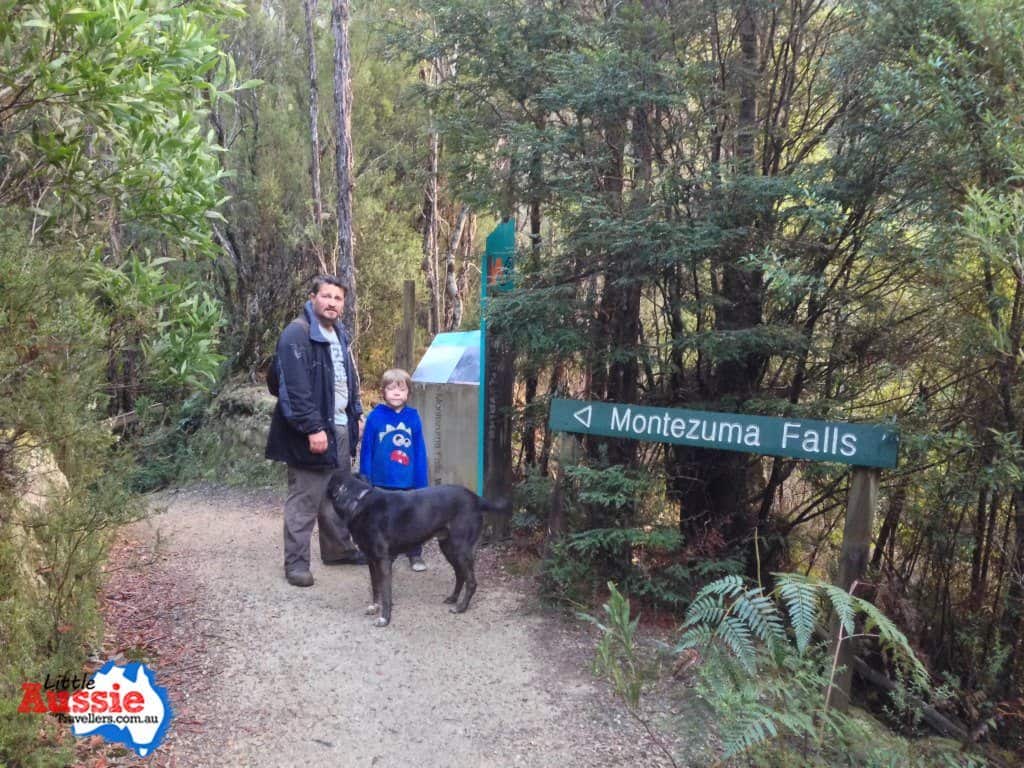
It is also one of the longest treks we undertook in Tasmania at a total of 9.6kms return, but it rewarded us with amazing scenery, and a spectacular waterfall. The entire area was wet thanks to the few days of rainfall that had occurred before we’d arrived, and the morning of drizzle. This meant that the walking track was wet underfoot, and while we began by trying to dodge the puddles, it soon became apparent it was best just to go with the flow, deal with getting wet and muddy and just immerse ourselves fully into the experience.
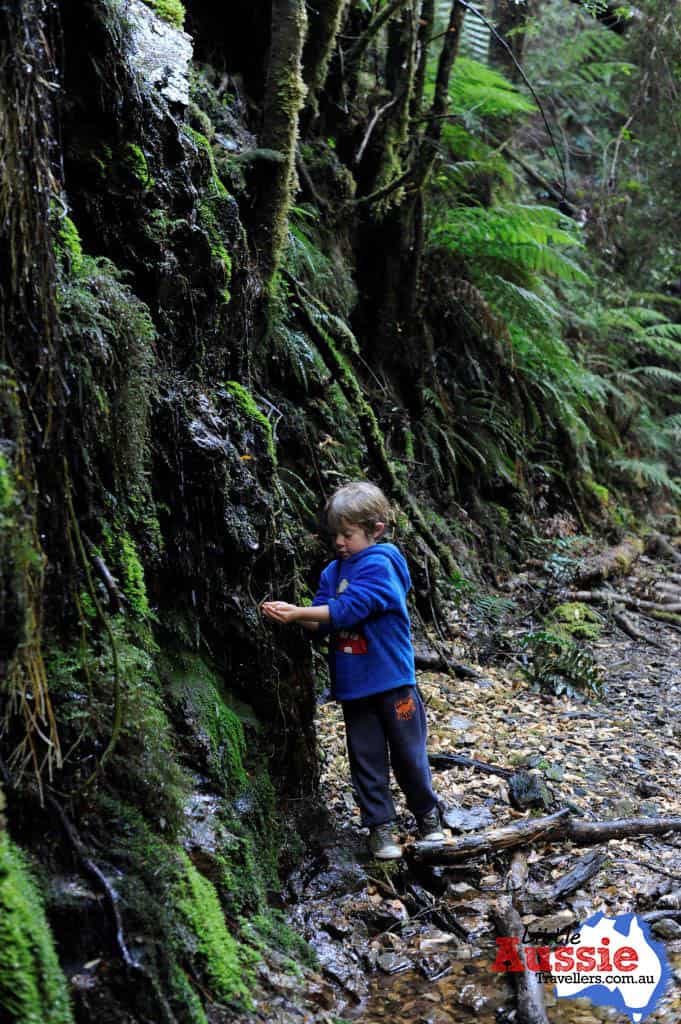
How Difficult is the Walk to Montezuma Falls?
The walk to Montezuma Falls is graded as easy and level. It follows the route of an historic light tramway that was built by hand, and you’ll walk right over the top of sleepers that have been laying in place ever since. If you’re there on a day like we were, gumboots would be a great option! During your walk you’ll come across amazing flora, beautiful trees, mosses, interesting fungi, and the sound of water streaming for most of your time taking in the scenery. It is easy to feel as though you’re in the middle of nowhere here, and you really are reasonable secluded, although despite the weather we shared the track with a few other adventurers on the way.
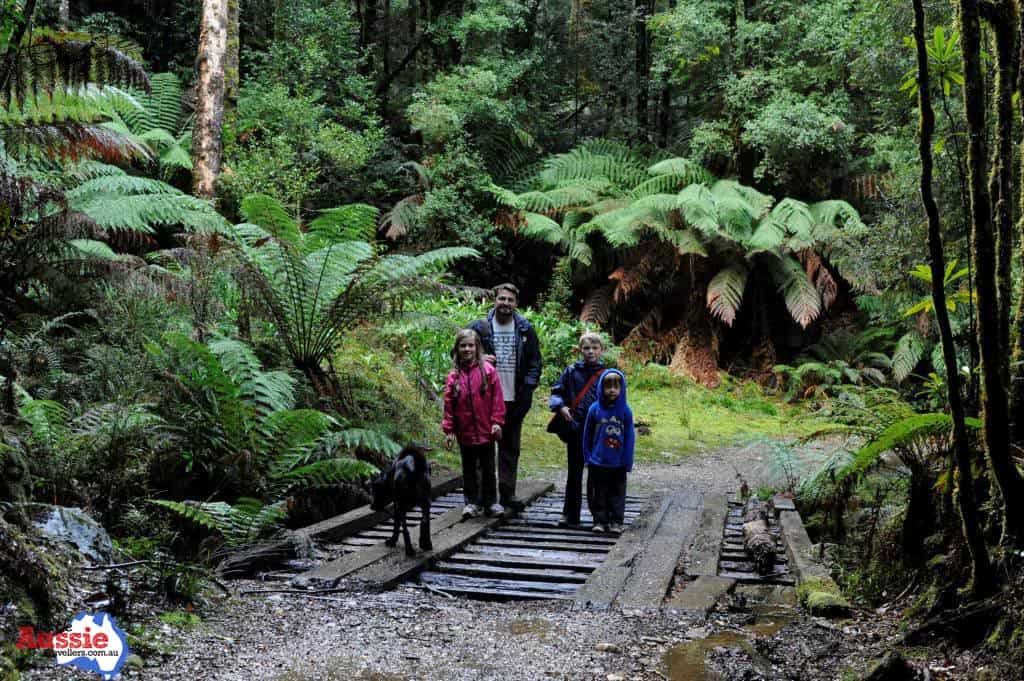
The entire walk took around 3 hours, and we walked at a reasonably steady pace during that time, mostly because we didn’t start until about 2pm in the afternoon and we wanted to make sure we were back at the start by night fall, as we had to get to our next camp.

As we got closer to the falls, we could hear them in the distance and after an hour of walking in the wet, everyone was pretty excited by reaching our goal. It was a nice surprise to come across an old mine shaft, which told of some of the mining of the region. The West of Tasmania has always been rich with mining operations and discoveries, but as we stood there in the damp, the mine shaft full of water under the walkway, I wondered how people survived the cold conditions in days gone by, especially as they had to forge their way through the landscape to create the very paths we were walking on.
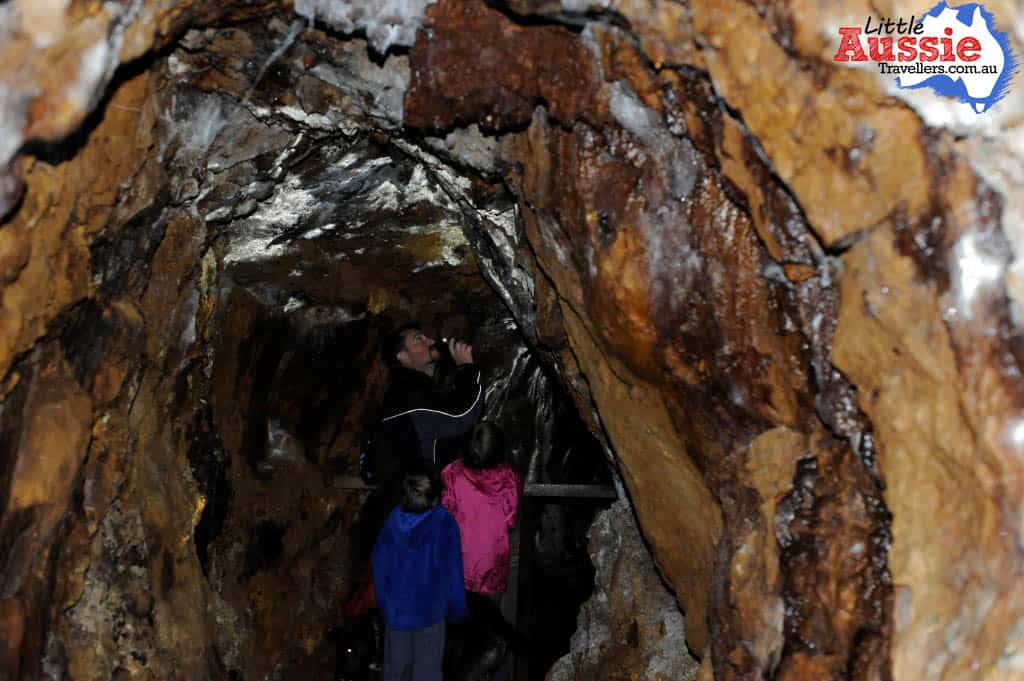
Is Montezuma Falls Walk Dog Friendly?
We wrote recently about the logistics of travelling Australia with a dog, and in Tasmania we were lucky that many of the places we wanted to explore allowed us to bring Yoshi along. The Montezuma Falls walk is one that allows dogs to explore with you, as long as they are on leash. We didn’t realise when we reached the waterfall that there was a very small suspension bridge that allowed us to get a better look at the falls. Of course, the first thing the kids did was take off across the bridge, before I made them stop for a snapshot:
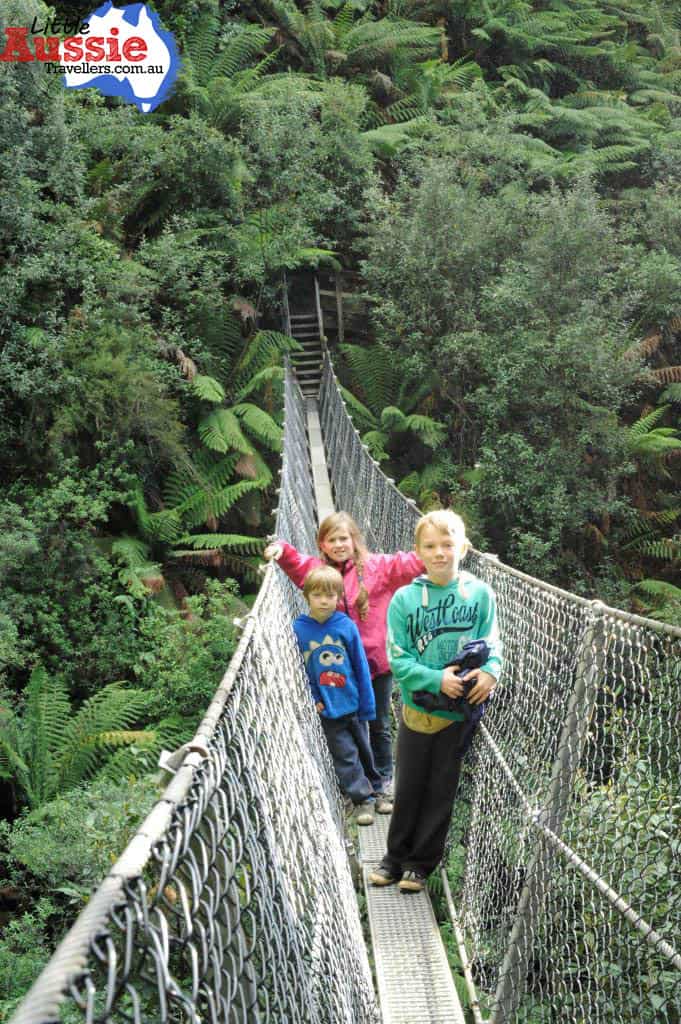
Please ignore their not-so excited expressions 😉 They desperately wanted to explore, not smile for a picture! The one thing we hadn’t realised was that Yoshi would follow wherever the kids went, and so off he went right across the suspension bridge!
I can only imagine what must go through a dog’s head when they realise they are standing, propped high above rushing water and a very large drop to the bottom. He was super brave and just focused on staying with his people, and it wasn’t until we coaxed him back that he got the wobbles up!
I do have a video which I’ll share, but the best option was for Matt to pick the poor boy up and carry him back. Not an experience I think Yoshi wants to repeat, although it was impossible for him to fall, of course as a dog, he wouldn’t quite realise that, so he was a very, very brave boy!
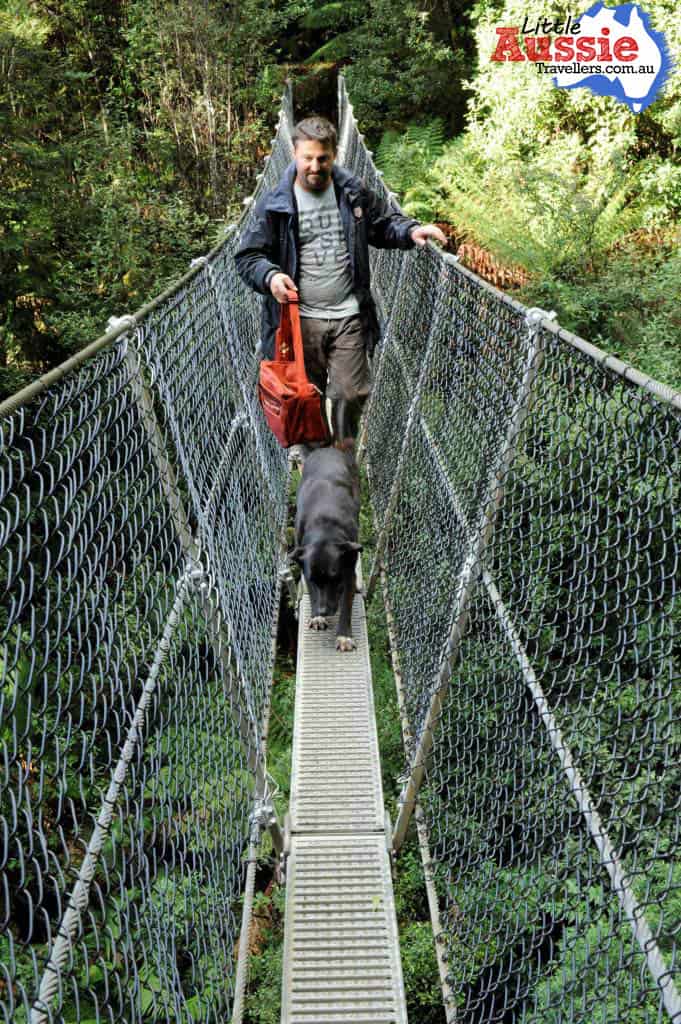
So, after we explored the suspension bridge, rescued the dog from his over enthusiastic adventure session, then it was time to walk up to the platform at the base of the falls. The strength of the water, the height of the falls, and the amazing scenery allow you to just stop, pause and breathe in the freshness and beauty that is the Tasmanian wilderness!
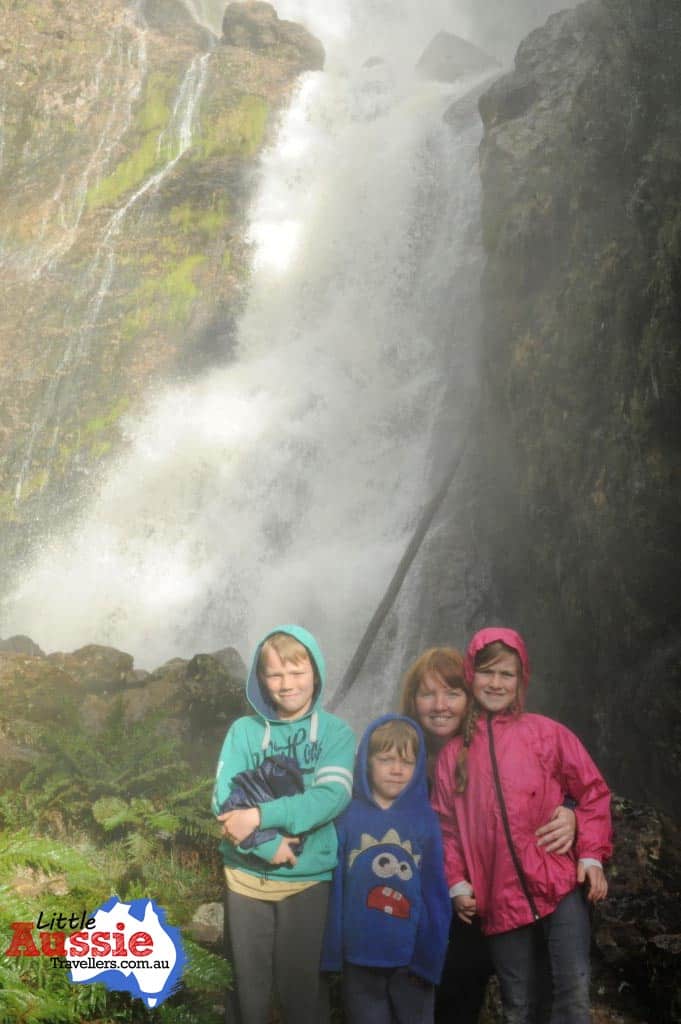
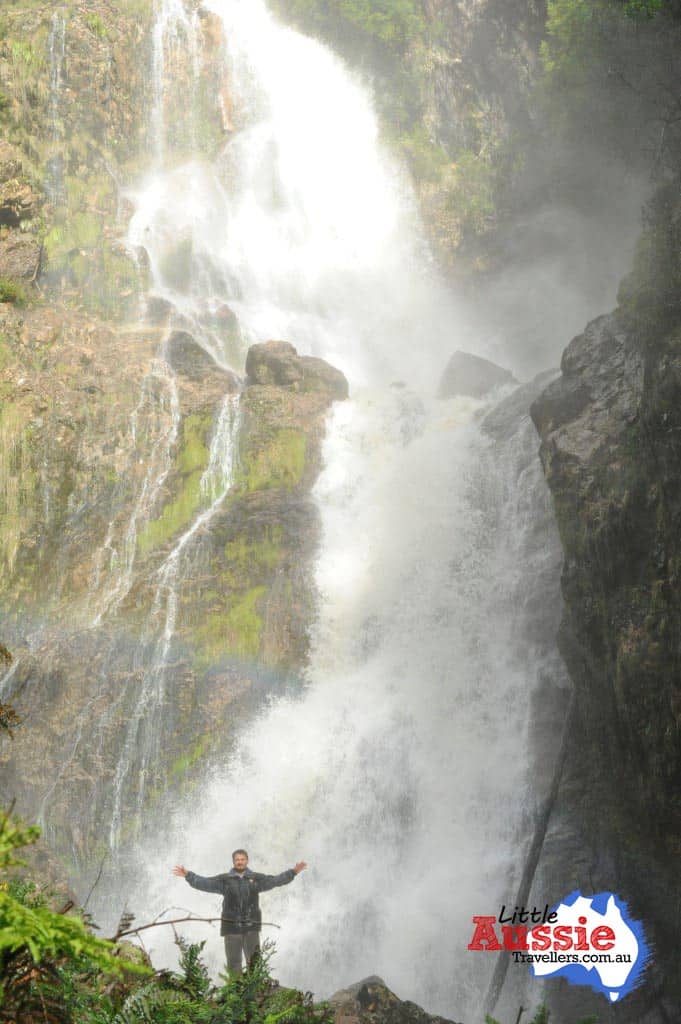
So, if you find yourself exploring Tasmania with kids, then we highly recommend the walk to Montezuma Falls. It might be a little challenging for really small legs, but for kids used to walking and happy to experience nature and go on a little bit of an adventure, then it’s a must-see in Tassie.
Tips for Montezuma Falls Walk with Kids
Be sure to pack plenty of water and snacks
If the weather has been wet, expect the walk to be wet underfoot, so you’ll be soggy if you don’t have gumboots or waterproof shoes.
Allow plenty of time. We did it in 3 hours which is the stated time on the sign, although I would have preferred to do the walk a bit more slowly so would have happily extended that amount of time, so leave earlier than we did (2pm) so you don’t have to worry about nightfall.

